#police army and government organisations
Explore tagged Tumblr posts
Text
fuck copaganda, all my homies hate copaganda…but lowkey there are some great shows and movies about feds
#sorry 😭😭#copaganda#like obviously#acab#but criminal minds bangs#and like X files?!!#fuck feds#x files#criminal minds#9 1 1#911 abc#brooklyn nine nine#zootropolis#life on mars#psych#line of duty#happy valley#james bond#captain america#lowkey#tell me i’m wrong#still fuck cops tho#fuck the police#🤷🏻♀️#sorry but also kinda not#listen this is me trying#this includes but is not limited to:#police army and government organisations
7 notes
·
View notes
Text
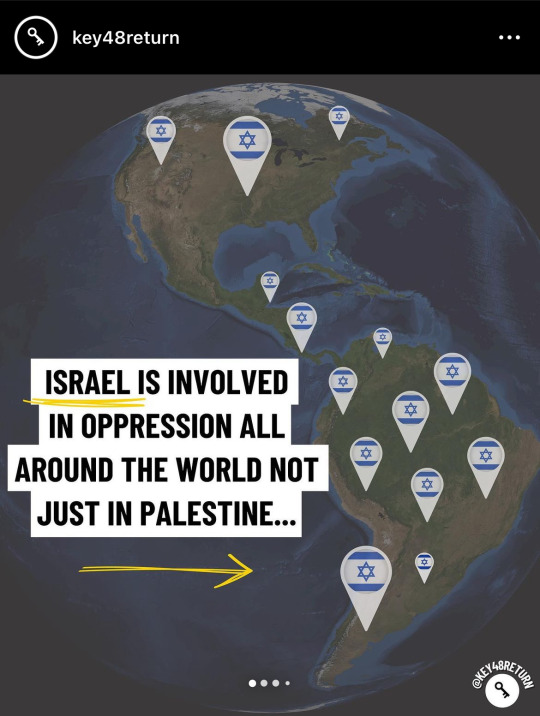
ID 1: Screenshot of a post by @/key48return on Instagram. Background is of a globe with pinpoints of the israeli flag all over North and South America. Title reads in all caps, “israel is involved in oppression all over the world not just in Palestine…” A yellow arrow points right underneath the title. End ID
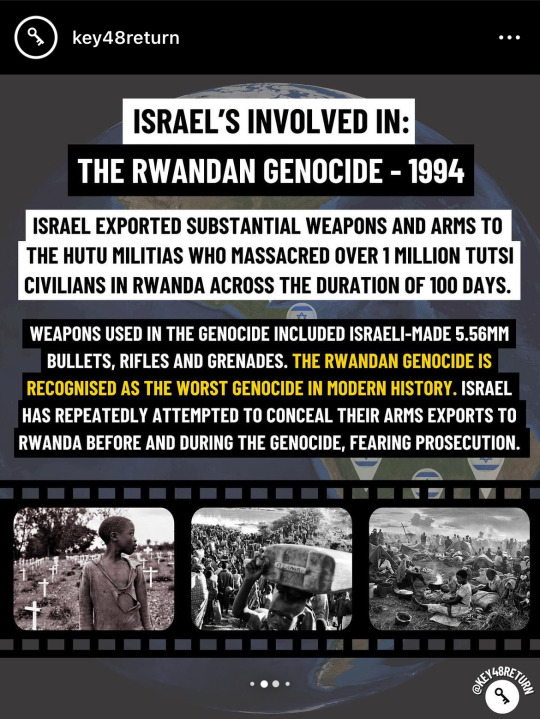
ID 2: In all caps, “ISRAEL'S INVOLVED IN:
THE RWANDAN GENOCIDE - 1994
ISRAEL EXPORTED SUBSTANTIAL WEAPONS AND ARMS TO THE HUTU MILITIAS WHO MASSACRED OVER 1 MILLION TUTSI CIVILIANS IN RWANDA ACROSS THE DURATION OF 100 DAYS.
WEAPONS USED IN THE GENOCIDE INCLUDED ISRAELI-MADE 5.56MM BULLETS, RIFLES AND GRENADES. THE RWANDAN GENOCIDE IS RECOGNISED AS THE WORST GENOCIDE IN MODERN HISTORY. ISRAEL HAS REPEATEDLY ATTEMPTED TO CONCEAL THEIR ARMS EXPORTS TO RWANDA BEFORE AND DURING THE GENOCIDE, FEARING PROSECUTION.”
Black and white photos below are shown of various Rwandan children in graveyards or in makeshift tents just trying to get by. End ID.
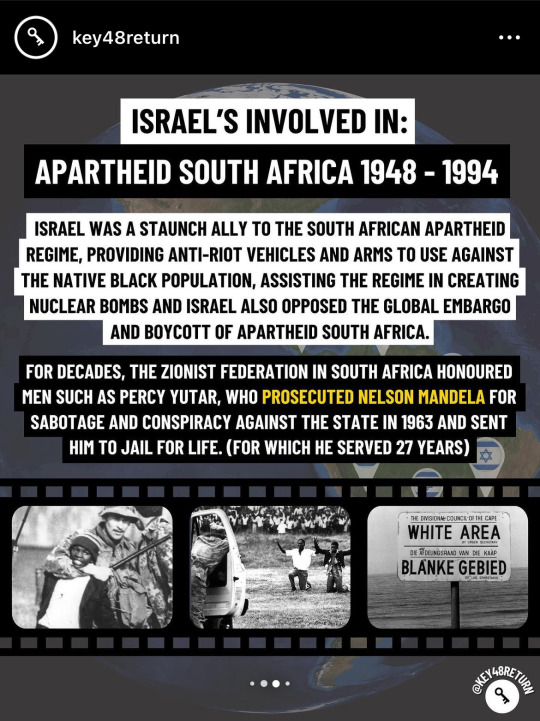
ID 3: In all caps, “ISRAEL'S INVOLVED IN:
APARTHEID SOUTH AFRICA 1948 - 1994
ISRAEL WAS A STAUNCH ALLY TO THE SOUTH AFRICAN APARTHEID REGIME, PROVIDING ANTI-RIOT VEHICLES AND ARMS TO USE AGAINST THE NATIVE BLACK POPULATION, ASSISTING THE REGIME IN CREATING NUCLEAR BOMBS AND ISRAEL ALSO OPPOSED THE GLOBAL EMBARGO AND BOYCOTT OF APARTHEID SOUTH AFRICA.
FOR DECADES, THE ZIONIST FEDERATION IN SOUTH AFRICA HONOURED MEN SUCH AS PERCY YUTAR, WHO PROSECUTED NELSON MANDELA FOR SABOTAGE AND CONSPIRACY AGAINST THE STATE IN 1963 AND SENT HIM TO JAIL FOR LIFE. (FOR WHICH HE SERVED 27 YEARS)”
Black and white photos below showcase a Black man being held in a chokehold by a white man, two Black people on their knees and hands up trying not to get shot, and a sign that reads in english and afrikaans “white area.” End ID.
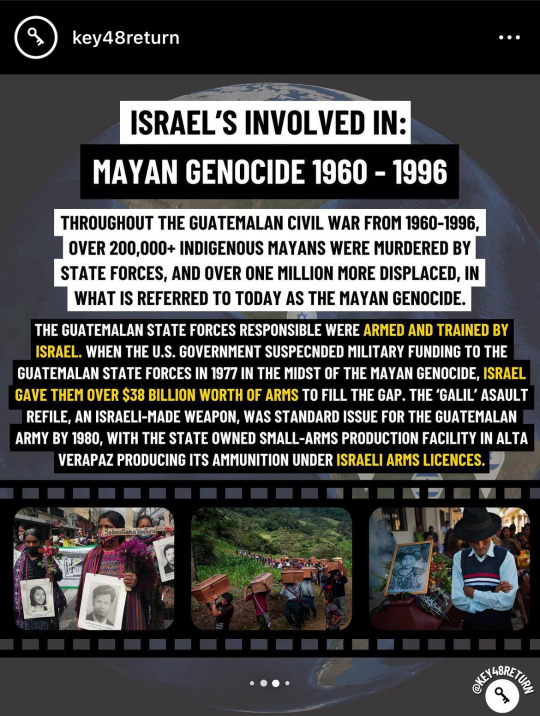
ID 4: In all caps, “ISRAEL'S INVOLVED IN:
MAYAN GENOCIDE 1960 - 1996
THROUGHOUT THE GUATEMALAN CIVIL WAR FROM 1960-1996, OVER 200,000+ INDIGENOUS MAYANS WERE MURDERED BY STATE FORCES, AND OVER ONE MILLION MORE DISPLACED, IN WHAT IS REFERRED TO TODAY AS THE MAYAN GENOCIDE.
THE GUATEMALAN STATE FORCES RESPONSIBLE WERE ARMED AND TRAINED BY ISRAEL. WHEN THE U.S. GOVERNMENT SUSPENDED MILITARY FUNDING TO THE GUATEMALAN STATE FORCES IN 1977 IN THE MIDST OF THE MAYAN GENOCIDE, ISRAEL GAVE THEM OVER $38 BILLION WORTH OF ARMS TO FILL THE GAP. THE 'GALIL' ASAULT RIFLE, AN ISRAELI-MADE WEAPON, WAS STANDARD ISSUE FOR THE GUATEMALAN ARMY BY 1980, WITH THE STATE OWNED SMALL-ARMS PRODUCTION FACILITY IN ALTA VERAPAZ PRODUCING ITS AMMUNITION UNDER ISRAELI ARMS LICENCES.”
Below are multiple in-color photos of Mayan families mourning, one photo in particular which shows indigenous Mayans carrying a seemingly endless line of coffins off into the distance. End ID.
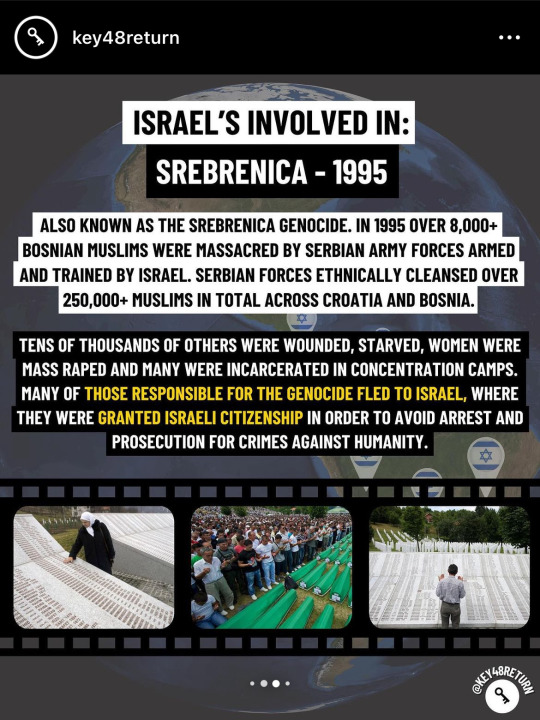
ID 5: In all caps, “ISRAEL'S INVOLVED IN:
SREBRENICA - 1995
ALSO KNOWN AS THE SREBRENICA GENOCIDE. IN 1995 OVER 8,000+ BOSNIAN MUSLIMS WERE MASSACRED BY SERBIAN ARMY FORCES ARMED AND TRAINED BY ISRAEL. SERBIAN FORCES ETHNICALLY CLEANSED OVER 250,000+ MUSLIMS IN TOTAL ACROSS CROATIA AND BOSNIA.
TENS OF THOUSANDS OF OTHERS WERE WOUNDED, STARVED, WOMEN WERE MASS RAPED AND MANY WERE INCARCERATED IN CONCENTRATION CAMPS. MANY OF THOSE RESPONSIBLE FOR THE GENOCIDE FLED TO ISRAEL, WHERE THEY WERE GRANTED ISRAELI CITIZENSHIP IN ORDER TO AVOID ARREST AND PROSECUTION FOR CRIMES AGAINST HUMANITY.”
Once again, the in-color photos below show various peoples mourning. Two of the photos specifically show people reaching their hands out over extremely long lists of just names of people who have died. End ID.

ID 6: In all caps, “ISRAEL'S INVOLVED IN:
TRAINING U.S. POLICE
SINCE 1990, HUNDREDS OF AMERICAN POLICE OFFICERS, INCLUDING AGENTS FROM THE FBI, CIA AND IMMIGRATION AND CUSTOMS ENFORCEMENT (ICE), HAVE EITHER BEEN SENT TO ISRAEL THROUGH POLICE TRAINING EXCHANGES, OR ATTENDED SUMMITS WITHIN THE U.S. THAT WERE SPONSORED BY ISRAELI LOBBY ORGANISATIONS.
THE KNEE-TO-NECK 'RESTRAINT' THAT DEREK CHAUVIN MURDERED GEORGE FLOYD WITH, IS OFTEN USED BY ISRAELI POLICE AND SOLIDERS AGAINST PALESTINIANS.
BLACK LIVES MATTER.”
Photos below are in-color and show various B.L.M. protests. End ID.

ID 7: In all caps, “ISRAEL'S INVOLVED IN:
ARMING INDIA'S VIOLENCE IN KASHMIR
INDIA IS ISRAEL'S LARGEST ARMS CLIENT, MAKING UP OVER 45% OF ISRAEL'S ARMS SALES. BUYING ISRAELI AMMUNITION AND AIR-TO-GROUND MISSILES, ON THE PREMISE THEY HAVE BEEN 'BATTLE-TESTED' ON PALESTINIANS IN GAZA. ISRAEL PROVIDES INDIA WITH THE ARMS INDIA USES TO MILITARILY OCCUPY KASHMIR AND BRUTALISE KASHMIRI'S.
SINCE 1989, OVER 100,000+ KASHMIRIS HAVE BEEN KILLED BY INDIAN FORCES. WITH OVER 7,200+ KASHMIRIS BEING MURDERED IN INDIAN POLICE CUSTODY, OVER 110,000+ KASHMIRI CHILDREN HAVE BEEN ORPHANED, AND MORE THAN 11,000+ KASHMIRI WOMEN HAVE BEEN RAPED BY INDIAN OCCUPATION FORCES. IN ADDITION, OVER 7,000+ UNNAMED MASS GRAVES HAVE BEEN DISCOVERED WITH THOUSANDS OF VICTIMS.”
The photos below show israel and india’s leaders shaking hands and various armed indian soldiers stopping Kashmiris for unnecessary checks. End ID.
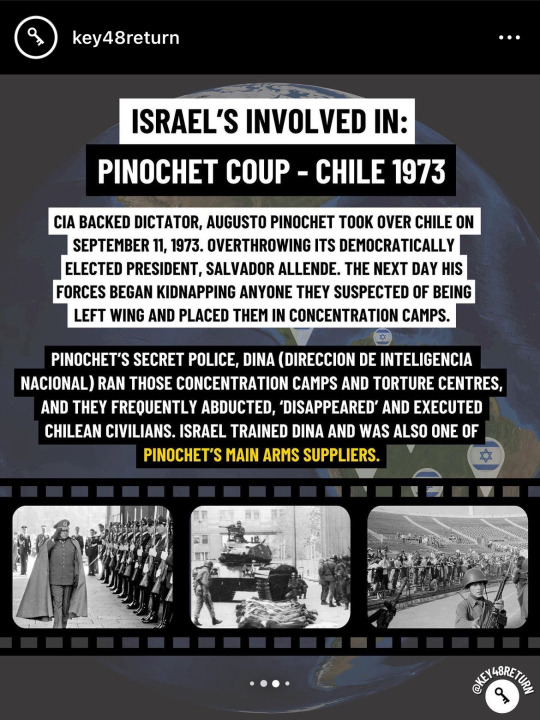
ID 8: In all caps, “ISRAEL'S INVOLVED IN:
PINOCHET COUP - CHILE 1973
CIA BACKED DICTATOR, AUGUSTO PINOCHET TOOK OVER CHILE ON SEPTEMBER 11, 1973. OVERTHROWING ITS DEMOCRATICALLY ELECTED PRESIDENT, SALVADOR ALLENDE. THE NEXT DAY HIS FORCES BEGAN KIDNAPPING ANYONE THEY SUSPECTED OF BEING LEFT WING AND PLACED THEM IN CONCENTRATION CAMPS.
PINOCHET'S SECRET POLICE, DINA (DIRECCION DE INTELIGENCIA NACIONAL) RAN THOSE CONCENTRATION CAMPS AND TORTURE CENTRES, AND THEY FREQUENTLY ABDUCTED, 'DISAPPEARED' AND EXECUTED CHILEAN CIVILIANS. ISRAEL TRAINED DINA AND WAS ALSO ONE OF PINOCHET'S MAIN ARMS SUPPLIERS.”
Black and white photos below showcase various scenes of armed DINA officers, with one photo in particular showing them in a tank over bodies on the ground, presumably dead. End ID.
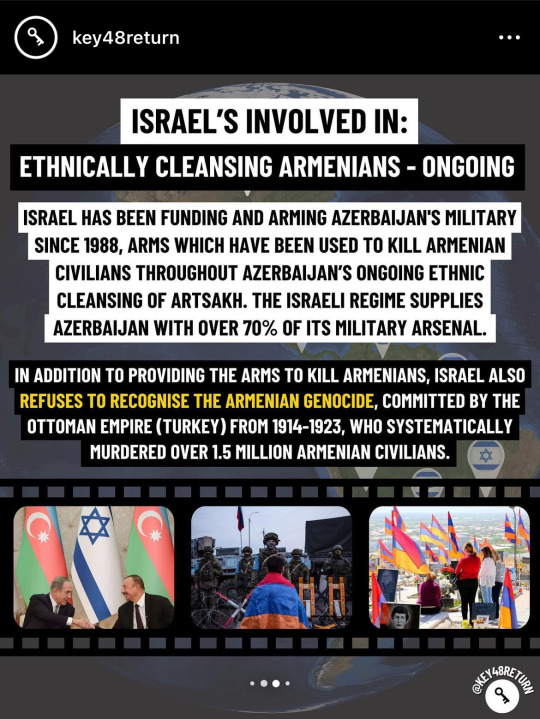
ID 9: In all caps, “ISRAEL'S INVOLVED IN:
ETHNICALLY CLEANSING ARMENIANS - ONGOING
ISRAEL HAS BEEN FUNDING AND ARMING AZERBAIJAN'S MILITARY SINCE 1988, ARMS WHICH HAVE BEEN USED TO KILL ARMENIAN CIVILIANS THROUGHOUT AZERBAIJAN'S ONGOING ETHNIC CLEANSING OF ARTSAKH. THE ISRAELI REGIME SUPPLIES AZERBAIJAN WITH OVER 70% OF ITS MILITARY ARSENAL.
IN ADDITION TO PROVIDING THE ARMS TO KILL ARMENIANS, ISRAEL ALSO REFUSES TO RECOGNISE THE ARMENIAN GENOCIDE, COMMITTED BY THE OTTOMAN EMPIRE (TURKEY) FROM 1914-1923, WHO SYSTEMATICALLY MURDERED OVER 1.5 MILLION ARMENIAN CIVILIANS.”
Photos below show israel and azerbaijan’s leaders shaking hands, azerbaijan’s soldiers menacingly standing in front of someone wrapped in an Armenian flag, and Armenians mourning over a shrine with their flags all around them. End ID.

ID 10: In all caps, “THE PALESTINIAN STRUGGLE FOR FREEDOM IS CONNECTED TO STRUGGLES ALL AROUND THE WORLD.
BECAUSE OPPRESSORS LIKE ISRAEL ARE NOT ONLY UPHOLDING OPPRESSION AGAINST ONE POPULATION, ITS ALWAYS INTERCONNECTED TO OPPRESSING MANY MORE.
FREE PALESTINE.” No photos at the bottom of this slide. End ID.
#reaux speaks#oppression#genocide#ethnic cleansing#apartheid#israel#palestine#free palestine#black lives matter#history#rwanda#africa#south africa#nelson mandela#mayans#guatemala#srebrenica#muslim#police brutality#kashmir#india#narendra modi#benjamin netanyahu#augusto pinochet#chile#armenia#artsakh#azerbaijan#bosnia#serbia
3K notes
·
View notes
Text
ROUND THREE: MATCH-UP ONE

Remember, this is NOT about who would win in a fight. This is about who makes the best leader for Mandalore as a whole.
Explanation post
Seeding
Propaganda below the cut! You can submit more on this post and I will reblog it back to here!
SATINE KRYZE
Anon: Satine because she served. Mandalorian fashion week would love her. Manda'slay.
Anon: Satine Propaganda: Was supported by the STRONG MAJORITY, led Mandalore to be in peace for NEARLY 20 YEARS, didn't ban mando'a or armour or any part of the culture like fandom claims, is a good fighter, considered EVERY Mandalorian a Mandalorian and didn't discriminate
@lightsaberwieldingdalek: Satine propaganda: she actually ran a functioning government. Not a mercenary band, or a death cult, or a terrorist extremist organisation, an actual functioning government. Yes there was corruption, corruption she did her best to stop to the point of personally getting in firefights with smugglers, but she took a planet devastated by civil war and by the end of her rule she had schools, public works, and a justice system. - Sure, the rest can run military operations (and we don’t know Satine couldn’t, only that she *won’t*) but can they make the bins get emptied regularly to go to the recycling plants?
COMMANDER CODY
Anon: Propaganda for Commander Cody: - Cody was a student of Alpha-17, who in turn had been personally trained by former Mand'alor Jango Fett, giving him a strong training lineage claim to the title - Cody's service as Marshall Commander in the GAR gave him a lot of the diplomatic, organizational, and military experience needed to govern a planet like Mandalore
@spacetime1969: This man has led more people at once than anyone on this list.
Anon: Cody should be Mand'alor because it would be unspeakably sexy
@cha0s-cat: Cody has experience with negotiating from accompanying Obi-Wan, he leads a massive amount of his brothers already. Can recognize when there is a need for negotiations vs a need for violence. This would balance out the majority of the two factions (pacifists/traditionalists) excluding the extremists on either end. And with the amount of chaos that he has to deal with when it comes to Obi-Wan and Anakin, this would probably be relaxing.
@skykind: - Has resisted fascism and its attendant police/military state at great personal risk (Bad Batch 2.3), which is apparently necessary to successfully govern Mandalore so long as Death Watch is fully armed and also backed by someone more cunning than their usual leadership (Clone Wars 5.15). - Possesses exceptional leadership and organizational ability from his time as one of the highest-ranked Clone officers of the GAR. The Clone Wars and Bad Batch narratives furthermore present him as Obi-Wan’s peer, so he should be interpreted as equally skilled, wise, kind, and unhinged-in-battle as Obi-Wan. Jury’s out on the sarcasm. - Turns to diplomacy before fighting (Bad Batch 2.3). - Has caught a Jedi’s lightsaber mid-battle at least two times (Clone Wars 1.20 and Revenge of the Sith). This is a very useful skill to have as the prospective or current leader of people who keep chucking the darksaber about. - Has returned a lightsaber to a Jedi at least two times. This is a crucial skill to have as the prospective or current leader of people who should stop selecting said leader via darksaber acquisition.
@antianakin: [From the Boba vs Cody poll] So in a very practical sense, if I'm just looking at it with the question of "Who actually has the skills to be a good leader of people" [between Boba and Cody] then the answer is undoubtedly Cody. Cody was trained his entire life presumably to be a Commander in a large army and seems to do that very successfully for three years. He seems fairly humble, has good teamwork skills, he's kind and understanding and merciful, and he's a very skilled fighter. All of this would serve him exceedingly well if he chose to take on a leadership position, on Mandalore or otherwise. - The one downside to Cody is that Cody shows exactly zero interest in Mandalore at all. Cody does not identify as a Mandalorian at any point and never seems like he'd want to, let alone LEAD the Mandalorians. I do not personally see Cody actually being WILLING to lead Mandalore if offered the opportunity, even if he'd definitely have the skills to do so. I feel like if it were offered to him or fell into his lap somehow, he'd just pass it off immediately to the next most qualified person who was interested in it. Mandalore is not his problem or his responsibility and he's not about to change that.
There was a lot of discourse on the Bo-Katan vs. Cody poll, but it was largely "this is why the other character is a bad choice" rather than "this is why my fave is a good choice," so there isn't really a good way to include it.
#satine kryze#commander cody#star wars#the clone wars#tumblr tournaments#mandalore#tumblr brackets#sw events#polls#sw legends
381 notes
·
View notes
Text
WorldBuilding Ask Game

Here is a little ask game for WorldBuilding in your WIP to pad out one country or all of them! Use it for yourself or ask a friend and spread some love. Focus on a particular section and have fun!
Geography
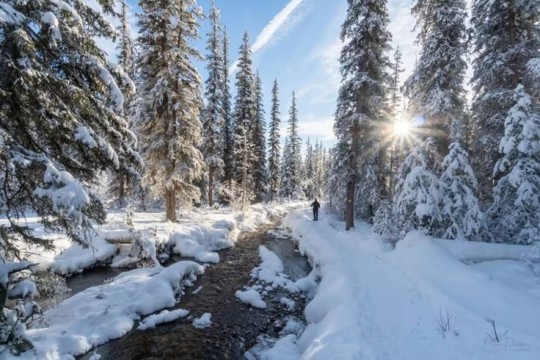
What does your world look like? What's the biome? Are there different ones?
Are there any oceans? If so, are they accessible? Are they a reliable source of travel and food?
Are there any rivers in your world? Any lakes? What's the longest river? Deepest lake?
Is there a safe supply of drinking water? If not, why not?
Are there mountains in your world? What's the highest one?
What is the weather like? How does this effect life?
What animals inhabit the world? What animals are indigenous or considered exotic?
What are some natural features your world is famous for? Is your world considered beautiful?
How many countries in your world?
How are countries divided? By natural lines or by agreements?
Population
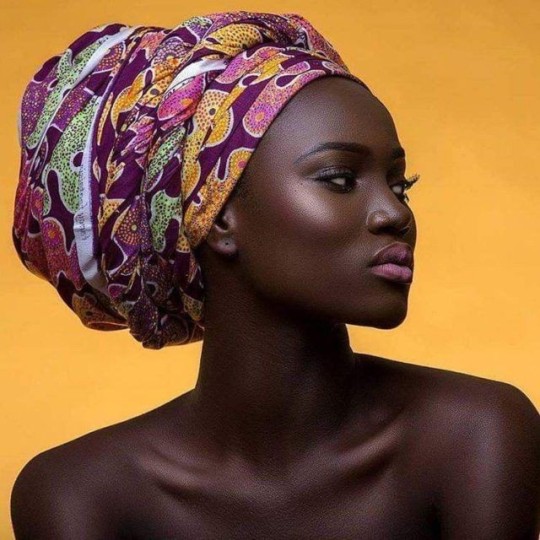
What's the population like? Is it large or sparse?
Is there any factors in population density? Do more people live in a certain area more than elsewhere? Why is that?
Are there different peoples living in your world? If so, how do they get on?
How important is nationality? Are foreigners tolerated? Or are they unwelcome?
What countries get on? What countries hate one another?
Are there any important cities? Why are they important?
What's the architecture like? Are there any outside influences?
What's a typical building material? What's considered an expensive feature to include?
What is infrastructure like? Are roads and railways in good condition?
Is there public transport? Is it reliable?
Government
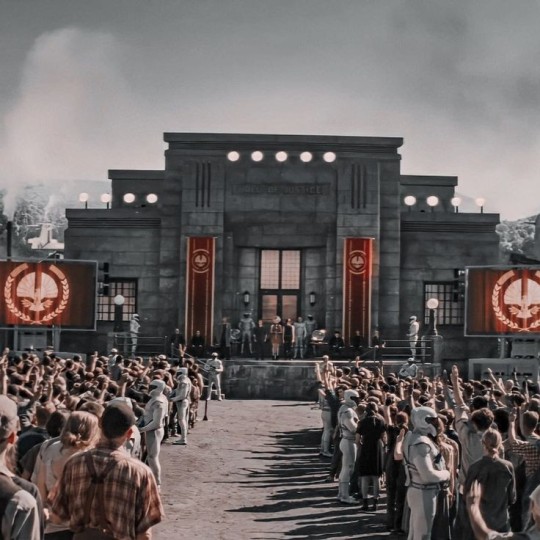
What system of government does your world adhere to? Is it popular?
Where is the seat of government?
Are there different governmental agencies?
Are there political parties? If so, what are their goals?
How much control does the government have over the average person?
Can your people vote? If not, why not? If so, who has/hasn't the right to?
Are there any parties or organisations that oppose the government?
How does the government crack down on sedition?
Are people allowed to criticise the government? If so, how? If not, how do they get around it?
How are laws made? Who makes them?
Is there any odd laws in your world?
What are some punishments to crime? Are they considered fair?
What crimes are unfathomable for the people?
Who handles justice? Is justice obtainable for all?
Are there any police? What's their reputation?
What role does the military play in your world?
Who controls the army? Head of state or government as a whole?
Is it considered a good career path?
Who can join the army? Are there any restrictions?
What is your world's stance on war? Are there any neutral parties? Or particularly warlike ones?
Commerce and Trade
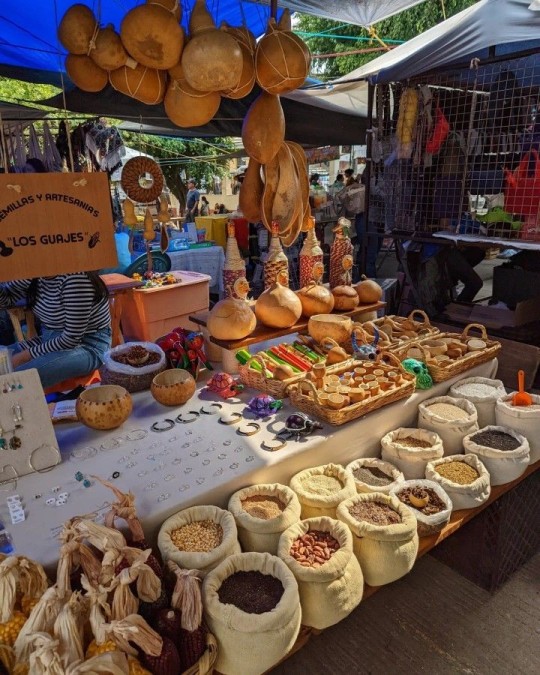
How is trade done?
Is currency universal or dictated by region?
How is your economy going? What effects it?
What trade is your world known for?
What are some exports? What must your world import?
Are any goods considered luxurious?
What services are available in your world? What services are niche?
What sort of work is common? Is work readily available?
Who is expected to work?
Are workers treated fairly or unfairly?
Are there any ways workers are protected? If not, what are some consequences?
Is your world more reliant on technology or on labour?
Is agriculture possible in your world? If so what can your people grow?
How big is industry? What goods can your people make?
What resources can your country exploit?
What are some barriers to trade and commerce?
Is your nation known for quality? Or Quantity?
Who does your country trade with most often? Who do they boycott?
Are there any major ports in your country?
Are there any banned goods? If so, is there a black market for their purchase?
Society
How society expect one to behave in public? Are there different expectations for different people/genders/ranks?
Is there a social order? Can one move up the ranks?
Is there any considerations made on account of rank, gender, age or position?
What is considered a social faux pas?
Are there any gestures or actions that are considered rude or socially unforgivable?
What would utterly shock somebody to see somebody do?
What are some opinions that are normal for your world but can be considered subversive in real life?
How can one rise up the status ladder? Is there much trouble to do so?
What denotes a person's place in society?
How is life different in cities compared to life in the countryside?
Daily life
Where would someone go to buy their weekly shop? Is food easy to come by?
What would be the daily routine of the wealthy? The common man?
How is hygiene handled in your world? Where does one go to spruce up?
What would be some day to day tasks one might face?
What is the favoured means of travel?
Are there any problems in your world that could effect a daily routine? Potholes? Gigantic spiders? Acid rain?
What ammenties would an average person expect to have access to?
Where would one go if they are injured or ill? What's healthcare like?
Do people feel safe where they live? Are there any places somebody might face danger?
How do people communicate? Is it difficult? Why?
What do people do for fun? What's considered normal fun versus hedonistic?
What pastimes are common? What kind aren't?
Is education valued?
Is there access to education? If so, for who?
Are the population educated? If so to what extent?
Family Life
What is the typical family set up?
Is extended family important?
Who can be considered family? Who can't be?
Is marriage considered a duty? Or is it more of a personal choice?
Is divorce possible?
Can people adopt children?
What happens to orphaned children?
Are children important? If not, why not? If so, why?
What are some typical toys children play with?
What are some games children play with one another?
How is in charge of household chores?
Is there a hierarchy in families?
Are children expected to take on certain roles?
What is the living situation like between the different ranks? Are the roles different?
What's considered the proper way to raise a child?
Culture and Languages
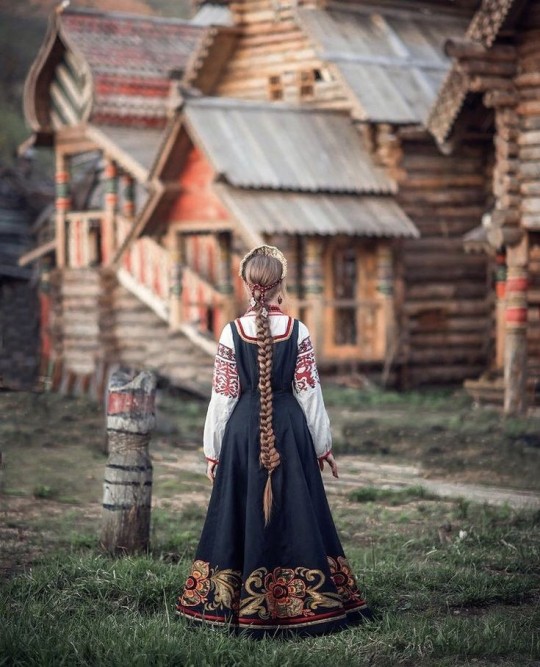
Are there multiple cultures in your world? How do they differ? Do they mesh well together?
How are cultures similar? How are they different?
Are there any traditions in your world? How important is tradition?
What are some rituals your culture undertakes?
Are there any special days? Events?
What are some traditional values in your world? Does it effect daily life?
Are there traditional clothes for your world? Are they something somebody wears on a daily basis or just on occasion?
Are there any rules around what people can wear?
What would be considered formal dress? Casual dress?
What would happen if somebody wore the wrong clothes to an event?
What languages are spoken in your world? If so, how do they sound?
Are there any dialects? If so, how do they sound?
Are most people monolingual? Or bilingual? Or multilingual?
Are there any languages that are closely related?
What is considered a universal language?
Religion
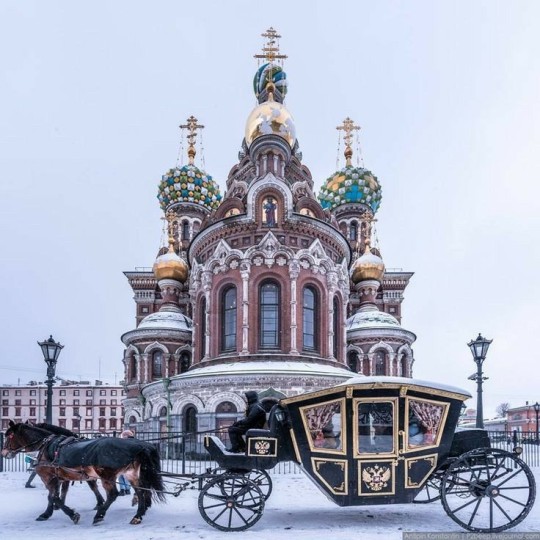
Is religion a thing in your world?
Is religion a staple of life or just a small part?
Does religion affect politics, personal lives and affiliations?
Is your world sectarian? Or ruled by religion?
What are some influences religion has on daily life?
What sort of religion is it? Monotheistic? Polytheistic?
What are some myths your people believe in?
What common rituals does one undertake on a day to day basis?
How does one please a deity?
Where do your people pray? How do they?
What symbols would denote a follower of a certain belief system to a stranger?
What places or objects are considered sacred?
Are there religious orders? If so, who can join?
Is there tolerance or violence over religion? If so, between which faiths?
Food and Drink

What are some traditional dishes in your world?
What would be a basic diet for the common man?
What's considered a delicacy?
Is there a societal difference in diet? What are the factors that effect diet between classes?
Is there any influence from other cuisines? If not, why not? If so, to what extent?
What would a typical breakfast contain?
What would lunch be?
What would be a typical dinner?
What meals are served during the day?
What's considered a comfort food or drink?
Are there any restrictions on who can eat what or when?
Are there any banned foods?
What stance does your world take on alcohol? Is it legal? Can anybody consume it?
Are there any dining customs? Are traditions?
Is there a difference in formal meals or casual meals? If so, what's involved?
Are there any gestures or actions unacceptable at the dinner table?
How are guests treated at meals? If they are given deference, how so?
Are there certain rules about how one can prepare food?
Are there any restrictions on eating with certain people?
How is food generally prepared by?
History
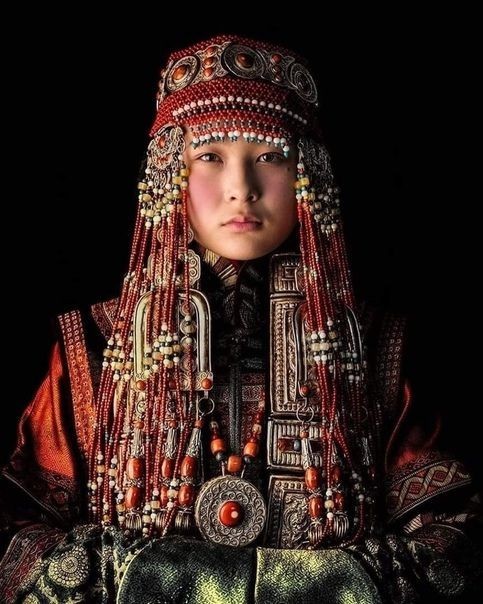
Who are some notable figures from history?
Who founded the country?
Is history looked back on with fondness? Or do your people rather forget?
Are there any heroes in history? Any villains?
What are some highpoints in the history of your land?
What are some points of history nobody likes to speak about?
Does history effect your land, people, culture, language in the present? If so in what ways?
What historic monuments are still around in the present day? What has been lost?
How do people learn about history? Do they learn the truth? Or just an abridged version?
What's a historical event that is important to the story?
#WorldBuilding Ask Game#WorldBuilding list#WorldBuilding reference#WorldBuilding research#WorldBuilding resource#WorldBuilding#writing#writeblr#writing resources#writing reference#writing advice#writers#Writing resources writing reference#Writing reference writing resources#Ask game#Writeblr ask game#writers on tumblr#spilled ink
2K notes
·
View notes
Photo

Einsatzgruppen
Einsatzgruppen ('deployment groups') were secret Nazi killing units, who systematically sought out and murdered civilians identified as enemies of the Third Reich. Operating without any legal restrictions in territories newly conquered by the regular German armed forces during the Second World War (1939-45), the Einsatzgruppen were responsible for over 2 million deaths.
The victims of the Einsatzgruppen included Jewish people, Romani people, intellectuals, local officials, communists, partisans, and anyone else considered enemies of the German Nazi state. Jewish people were a particular target as part of the Nazis' Final Solution. Victims were rounded up for immediate mass execution or internment in concentration camps. The activities of the Einsatzgruppen became clear during the post-war Nuremberg trials when both survivors and those directly involved in the units gave evidence.
The Final Solution
Reinhard Heydrich (1904-1942) was the first head of the Reich Security Main Office or RSHA (Reichssicherheitshauptamt), which included within it such terror organisations as the Nazi secret police (Gestapo), the criminal police (Kripo), and the military intelligence service of the Nazi Party, the Sicherheitsdienst (Security Section or SD). When Heydrich was assassinated by the Czech Resistance in May 1942, Ernst Kaltenbrunner (1903-1946) took over as the new permanent head of the RSHA. The leader of Nazi Germany, Adolf Hitler (1889-1945), gave the RSHA three main roles: policing and repressing enemies of Nazism, gathering intelligence, and eliminating those people identified by the Nazis as being racially inferior. In none of these roles was the RSHA limited by any legal restrictions. Those identified as enemies of the Third Reich need not have been guilty of any specific crime, and they were given no legal representation or means of appeal. In other words, any civilian could be rounded up, imprisoned, and executed without any reason given whatsoever. Those who tried to defend the innocent were very often beaten, imprisoned, or executed themselves.
Heydrich and his chief lieutenant Adolf Eichmann (1906-1962) were assigned by Hitler many diabolical projects, which included the Final Solution, that is the extermination of all Jewish people (the Holocaust). Other 'undesirables' and, therefore, targets of the RSHA, included Romani people, freemasons, communists, those with physical or mental disabilities, and anyone who might resist the Third Reich, such as priests and intellectuals (including doctors, civil servants, and teachers). As the German army advanced into new territories, particularly on the Eastern Front, more and more "enemies of the state" had to be dealt with. Additional "enemies" now included prisoners of war, partisans, former members of local government, and anyone associated with the authority of the previous regime. To eliminate these "enemies", the RSHA was given the task of organising highly secret mobile killing squads, which operated behind the advancing regular German army and very often with its cooperation. These squads were the Einsatzgruppen.
Reinhard Heydrich
Bundesarchiv, Bild 146-1969-054-16 / Hoffmann, Heinrich (CC BY-SA)
Continue reading...
41 notes
·
View notes
Text
Bangladesh’s top court has scaled back the quotas on government jobs that led to widespread student-led protests and violent clashes that killed more than 100 people.
On Sunday afternoon the supreme court overturned a ruling that had reintroduced quotas for all civil service jobs, meaning that 30% were reserved for veterans and relatives of those who fought in the Bangladesh war of independence in 1971.
The supreme court ruling, which was brought forward in light of the protests, stipulated that only 5% of jobs would now be reserved for descendants of freedom fighters and another 2% for those from ethnic minorities or with disabilities, with the rest open to candidates based on merit.
The return of the quotas, which had been scrapped in 2018, sparked anger among students, who argued they were unjust at a time of economic decline and unfairly benefited those in the ruling Awami League party, which was founded by those who fought in the independence war.
Peaceful demonstrations initially broke out on university campuses across the country as students mobilised through social media to demand an end to the quotas. However, the unrest turned violent last week as pro-government groups were accused of attacking the protesters with weapons and riot police used rubber bullets and teargas to break up protests.
Protesters hit back at police with bricks and stones in clashes across the country and stormed the headquarters of the state broadcaster in Dhaka, setting it alight. In another city, protesters broke into a prison and released hundreds of inmates.
The clashes between pro-government forces and protesters have left thousands injured and killed about 150, though the government has refused to release official data on the death toll. Witnesses have alleged that police violence is responsible for a large number of the fatalities.
The government has also imposed a communications blackout, with the internet shut down and phone lines widely jammed. At least 70 leaders of the political opposition and several student leaders and activists have also been arrested, accused of stirring up unrest.
As the court ruling was given on Sunday, the country remained under a strict indefinite curfew, with people banned from leaving their homes and gathering in any capacity. Police were granted “shoot on sight” orders for those who violated the curfew and the capital, Dhaka, resembled a war zone, with military personnel and tanks patrolling the streets and army helicopters flying low over the city. While the roads were largely deserted, protests continued in some quarters of the capital.
Student organisers said the supreme court ruling did not mean the end of the protests, which have escalated into the greatest challenge in years to the prime minister, Sheikh Hasina, with many calling for her resignation. Hasina, who has been in office since 2009, has been accused of authoritarianism and rampant corruption and her re-election in January was widely documented as rigged.
Mahfuzul Hasan, a protest coordinator from Jahangirnagar University, said they still had several demands that the government must meet before they would call off the demonstrations.
“Now we want justice for the lives lost of our brothers. The prime minister has to apologise and those who are guilty have to be tried,” he said. Hasan said student groups were also calling for the removal of vice-chancellors of universities where protesters faced violence, and politicians who spread inflammatory remarks about the protesters.
He said he was among many student protest leaders who now feared for their safety and were concerned about being “abducted” by law enforcement agencies, as has often happened to critics of Hasina’s government.
Hasib Al-Islam, a Dhaka university student and protest coordinator, said he saw the supreme court verdict as positive but said students were waiting to see how Hasina’s government responded and were demanding that a quota reform bill be passed through parliament.
Islam said: “Our protest against the quota system is already under way, and it will continue until the government issues a executive order in line with our reform demands.”
Among those calling for justice was the family of Abu Sayeed, a final year English student who killed in the protests on Thursday, allegedly by the police. A video of Sayeed being fired at by police during a protest at a university in the city of Rangpur had gone viral on social media before the government shut down the internet. Hospital sources said Sayeed had rubber bullet wounds on his body when he was brought in dead.
Sayeed’s brother Abu Hossain said Sayeed had been the only one in the family to make it to university. “The entire family was so proud of him; we had such high hopes for him,” said Hossain. “My parents are in shock; our only hope is lost.”
Hossain said his family stood behind the protesting students and wanted justice for his murder. “My brother died for demanding fair rights for every student,” he said. “He died a martyr. I hope he’ll be remembered for it and his death was not in vain.”
67 notes
·
View notes
Text
Israeli football fans clash with protesters in Amsterdam
Amsterdam city council member says ‘Maccabi hooligans’ instigated violence and attacked Palestinian supporters. Israeli football fans have clashed with apparent pro-Palestinian protesters before and after a Europa League football match between their team Maccabi Tel Aviv and Ajax in Amsterdam. The clashes took place outside the Johan Cruyff Arena on Thursday night, the city’s main arena and Ajax Amsterdam’s home stadium, as well as in other areas. Ajax won the match 5-0 after leading 3-0 at halftime. Reporting from Amsterdam, Al Jazeera’s Step Vaessen said the clashes were the result of a buildup in tensions over a few days. Hundreds of supporters of Maccabi Tel Aviv came to Amsterdam, held a very vocal rally in the main square before the incident, waving Israeli flags, and also took down a Palestinian flag,” she said. On Thursday, police had said on social media that they were being particularly vigilant in the wake of politically charged incidents, including the tearing down of a Palestinian flag from a building. Social media videos captured the reported incident, showing Israeli fans shouting slogans while an individual was taking the flag down. Before the game, videos showed crowds of Maccabi supporters chanting anti-Arab slogans. In one video, Israeli supporters were heard singing: “Let the IDF win, and f*** the Arabs!,” referring to the Israeli army’s offensive on Gaza. Another video captured a fan screaming: “F*** you terrorists, Sinwar die, everybody die,” in reference to the Hamas leader who was killed last month. The Israeli fans instigated the violence after arriving in the city and attacking Palestinian supporters before the match, an Amsterdam city council member said. “They began attacking houses of people in Amsterdam with Palestinian flags, so that’s actually where the violence started,” Councilman Jazie Veldhuyzen told Al Jazeera on Friday. “As a reaction, Amsterdammers mobilised themselves and countered the attacks that started on Wednesday by the Maccabi hooligans.” Israel’s Ministry of Foreign Affairs said 10 Israelis were injured. Prime Minister Benjamin Netanyahu’s office did not clarify what led to what it called a “very violent incident against Israeli citizens”. Netanyahu said, in a Friday statement issued by his office, that he “views the horrifying incident with utmost gravity and demands that the Dutch government and security forces take vigorous and swift action against the rioters, and ensure the safety of our citizens”. Netanyahu also ordered the country’s spy agency to draw up a plan to prevent violence at events abroad. “I have instructed the head of the Mossad [David Barnea] and other officials to prepare our courses of action, our alert system and our organisation for a new situation,” he said in a video statement during a meeting at the Foreign Ministry to oversee the evacuation of Israelis from Amsterdam. The Palestinian Ministry of Foreign Affairs condemned what it called “anti-Arab chants” and apparent attacks on the Palestinian flag. In a statement posted on X on Friday, it called on the Dutch government to “conduct an immediate investigation into the instigators of these disturbances and to protect Palestinians and Arabs residing in the Netherlands”. Amsterdam resident and activist Mo Kotesh told Al Jazeera Israeli fans attacked innocent people on the streets, property and taxi drivers on Wednesday and took down a Palestinian flag. Kotesh, of the Palestinian community in the Netherlands, said that they went to an area near the central Dam Square – as instructed by the municipality – to hold a peaceful demonstration on the day of the match. He said he saw locals trying to counter the violence started against them and their properties by Israeli fans. Israeli “hooligans” chanted songs swearing at Arabs, saying, “There are no schools in Gaza because there are no children left.’” Israeli political commentator Ori Goldberg told Al Jazeera the incident showed that the Israeli narrative had taken over Europe.
"The fact that Israeli fans riot in the middle of Amsterdam, sing racist songs and climb the walls of homes to tear down Palestinian flags … is part of the Israeli condition at the moment: A complete detachment between actions and consequences,” he said. On Friday, Al Jazeera’s Vaessen said the capital was calm. Arrests and injuries Amsterdam Mayor Femke Halsema had banned a pro-Palestinian demonstration amid concerns about tensions between protesters and supporters of the Israeli football club. About 600 police were deployed after rioting started between pro-Palestinian supporters and Maccabi fans, Al Jazeera’s Vaessen reported, adding that five people were briefly taken to hospital with light injuries. Police said on Friday that 62 people were arrested. Pro-Palestinian demonstrators had tried to reach the stadium, Vaessen said. According to police, the fans left the stadium without incident, but several clashes in the city centre were reported during the night. Veldhuyzen, the council member, said, “The mayor says the police did act, but I would say they acted not at the right moments.” He told Al Jazeera: “They acted only to protect the Maccabi hooligans when Amsterdammers stood up to defend their own people and defend their own houses. And this is when the police showed up to protect the Maccabi fans when they ran away after attacking people.” Dutch Prime Minister Dick Schoof said he followed the news of the rioting with “horror”, adding that “the perpetrators will be tracked down and prosecuted”. In a post on Friday on social media platform X, Schoof said, “Completely unacceptable anti-Semitic attacks on Israelis. I am in close contact with all those involved.” UEFA condemnation Israeli Foreign Minister Gideon Saar spoke to his Dutch counterpart, Caspar Veldkamp, and requested the Dutch government’s assistance in securing the departure of fans from hotels to the airport in Amsterdam. Saar “emphasised the seriousness with which Israel views the widespread violent attacks against its citizens throughout Amsterdam”, the Israeli Foreign Ministry said. Goldberg, the Israeli political commentator, said Israel’s reaction to the clashes reflected a “complete rejection of the notion that actions have consequences” given the Israeli fans’ actions in Amsterdam. The Israeli club, Maccabi Tel Aviv, was founded in 1906 in Jaffa, now part of Tel Aviv. It is languishing at the bottom of the Europa League table this season, at position 35 of 36. Its next game in the Europa League on November 28 will be against Turkish team Besiktas, based in Istanbul. However, following a decision by the Turkish authorities, the match will be played in a “neutral venue”. In a statement on Friday, the Palestine Football Association (PFA) said it was “gravely concerned by the sequence of violent events in Amsterdam”, specifically the “deplorable incitement to violence, anti-Palestinian racism, and Islamophobia expressed by Maccabi Tel Aviv fans”. The PFA called on football’s governing bodies FIFA and UEFA “to address the normalization of genocidal, racist, and Islamophobic rhetoric among Israeli football supporters and to implement concrete measures to combat this hostility”. European body UEFA earlier condemned the “acts of violence” before and after the match. “We trust that the relevant authorities will identify and charge as many of those responsible for such actions as possible,” it said in a statement.
(Source: Al-Jazeera)



#uefa europa league#Amsterdam riots#propaganda#media manipulation#Zionist propaganda#Zionist violence#western imperialism#anti Arab racism#islamophobia#Netherlands#antizionism#antisemitism#antifascist#fascism#football#free Palestine#knee of huss
17 notes
·
View notes
Note
Please tell me about the great emu war of 1932 :3
"Haha Australia lost a war to emus twice"
NO BUT YOU DON'T UNDERSTAND!!
Here's why:
First, I don't believe foreigners know how BIG emus are, and how much of their stocky main body is just layers and layers of feathers


This is Peck. He doesn't actually Peck but he LOVES the LADIES and for reference, that's me as he's uh... trying to woo me. I'm 4'11 / 149cm tall and in that photo he's not standing at full height either because he's preparing to get lower and ahem, grind. He is also a juvenile.
Emus are typically 5.7 feet/1.75 meters tall, but they have been recorded to get up to 6.2 feet/1.9 meters.
So imagine you've got this big ass dinosaur bird with the most t-rex looking feet perfectly designed for running. Yeeting. Skeeting. Killing you maybe. And now take into account these flightless fucks can run up to 62 Kilometers per hour. THATS 39 MILES PER HOUR TOP SPEED.
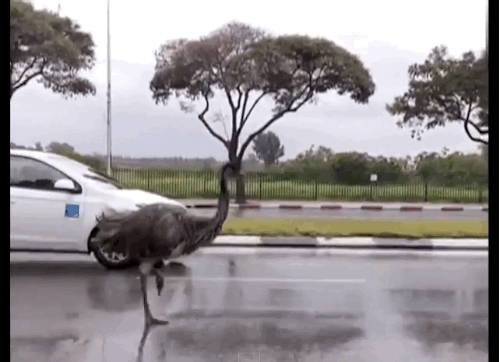
Now add 20,000 emus.
So 20,000 emus against poverty-stricken farmers with failing crops, farmers WHO WERE MOSTLY WW1 VETERANS BY THE WAY. Yeah nah.
Here's a visual to help y'all understand how insanely large emu groups get.

Onto why the hell were there so many emus on the farmlands (even tho... yknow... the emus and the local indigenous were there first but we won't get into that.)
Basically a big drought made the horde of emus move away from their usual dwindling territory, onto the sprawling Australian "farm lands" and remember I mentioned their feet before? BIG STOMPY. Whatever crops that had somehow managed to survive the severely vitamin-deficient soil and grow, did not in fact, survive the dinosaur feet as the emus strolled through, pecking and foraging the ground along the way.
The plight of the veteran farmers didn't fall on deaf ears, but the Australian government severely underestimated the power of 20,000 emus by a LONG shot. Plus they weren't all that interested either, until at least it was reported that the emus were destroying the Rabbit Proof Fence. What legends.
For the first "war" the government sent 3 men.
Yep. You heard me. Three guys. Major Meredith, Sargeant McMurray and a soldier by the name of O'Halloran.
They had one truck with a machine gun, and probably other guns, but between them roughly 10,000 rounds of ammunition.
So off they went. To wage war against the progressive emus breaking the symbol of "White Australia" AKA the Fence. Oh and also I guess the starving vets.
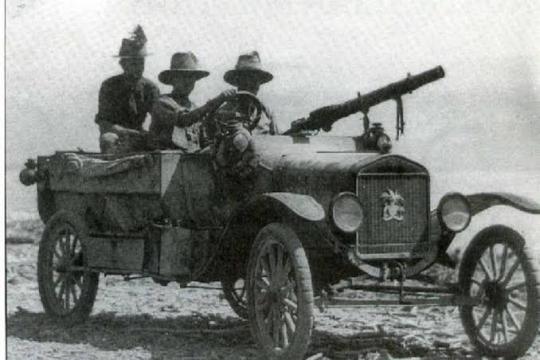
This is it. This is what they had.
Locals from all around joined in the fight and tried to herd the roaming groups of emus into the murder range but the emus had a tactic. One that us Aussies use at bush doofs when you hear police sirens- and that is to SCATTER.
They only killed "a dozen birds" from a group estimated to be around 1000. It didn't help that the machine gun jammed during this organised ambush.
And by then, the Emus clicked onto what was happening. They split up into smaller groups, observed to be led by the largest sized male who kept an eye out for the enemy. Never again did they risk coming together as seen before.
The war was lost. Only a few more attempts were made that had little success and Ornithologist Dom Serventy concisely summarised the whole operation.
I want to remind you all that this is a recorded statement, kept on file in legal military documentation
"The Emu command had evidently ordered guerrilla tactics, and its unwieldy army soon split up into innumerable small units that made use of the military equipment uneconomic. A crestfallen field force therefore withdrew from the combat area after about a month."
Let's move onto Emu War Part Two: Unsuccessful Boogaloo
Heads up by the way, TW below.
Emus were still, y'know, Emu-ing about and the drought didn't let up either. People were still dying of starvation, becoming homeless and committing suicide. It took the Premier of Western Australia, and a Base Commander in the military penning letters and using media pressure to finally convince the government to give it another go.
Major Meridith returns to the War and having learnt from practically everyone's past assumptions of the highly intelligent sonic-speed bird, brought success. And by that I mean, more success than the previous war.
Ultimately only 5% of the 20k Emu Army were ever killed, and even that is debated since it is more than likely they inflated numbers of kills to lessen the damage of being completely inferior to the superb qualities of the Emu.
A Federal parliamentarian (like a senator) when asked about whether there should be a medal made for the conflict, he replied with:
"Any medals should go to the emus who had won every round so far."
And of course in true Aussie fashion, the Defence Minister who supported and approved for the Emu War 1 and 2, was given the title by the Australian public, and international conservationists of ‘Minister for the Emu War’.
Ouch, but also, Not Every Problem Has To Be Solved With Guns.
Ironically what worked far better was the implementation of fences to keep the Emus OUT and unfortunately, a bounty system that saw many locals and professional hunters alike have FAR more success than an entire military operation. 57,000 bounties were claimed in a six month period after it being introduced in 1934.
Thus concludes the Great Emu War of 1932.
If you're asking why I know this, I studied it when I was 16, and made an entire poster to which I gave it to my Japanese Teacher. For context: I was living in Japan. Going to a Japanese School. And teaching my poor English teacher about this Emu War that he only believed once he looked it up. As a parting gift I gave him a poster. Shout out to Kawamura-Sensei you tried so hard not to laugh at the poster but I won that war.
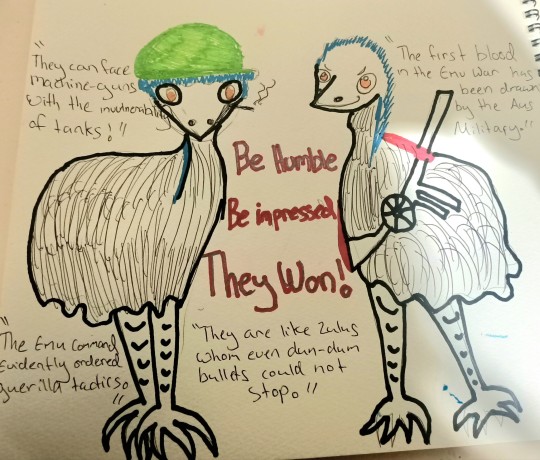
Here it is. All the quotes on there are real too!
#emu war#great emu war#the great emu war#emu#australian emu#australian army#australia#australian#emu meme#australian fauna#long post#history#australian history#major meridith#aus gov#aus history#auspol#bush doof#doof#aussie culture#aussie#animal death#birblr#bird#birb memes#bird death#animals#animalblr#wild birds#wild animals
122 notes
·
View notes
Text

On this day, 1 January 1994, the Zapatista uprising began, when Indigenous peoples in Chiapas, Mexico rose up and began reclaiming land.
As the North American Free Trade Agreement was due to come into effect, around 1000 members of the Zapatista National Liberation Army (EZLN) occupied the towns of Altamirano, Las Margaritas, Ocosingo, and San Cristobal de las Casas.
They released a statement declaring: “For many years, dictators have engaged in an undeclared genocidal war against our people. For this reason, we ask for your participation and support in our struggle for jobs, land, housing, food, health, education, independence, liberty, democracy, and justice, and peace. We will not stop fighting until these basic demands are met and a free and democratic government rules in Mexico.”
The rebels battled 14,000 Mexican colonial troops and police, and took over municipal buildings. In San Cristobal de las Casas, Zapatistas destroyed land records, and freed over 230 prisoners, most of whom were Indigenous peasants who had been locked up due to land disputes.
After 11 days of heavy fighting, a ceasefire agreement was reached, and between 159 and 300 people were dead. The Mexican army were accused of carrying out summary executions, arbitrary arrests and torture.
In their new, autonomous areas, Indigenous peoples took control of their communities, redistributed power and organised new, directly democratic ways of running society.
Despite state repression, violence and massacres, their movement of around 300,000 people remains self-managed to this day.
9 notes
·
View notes
Text
⚠️ WARNING GRAPHIC CONTENT⚠️
[ 📹 Horrific scenes from the recovery of a woman who was targeted by a Zionist sniper as she attempted to exit the Al-Said Hospital, in the north of Gaza, resulting in the immediate amputation of her leg. ]
🇮🇱⚔️🇵🇸 🚀🏘️💥🚑 🚨
DAY 242 IN THE ISRAELI OCCUPATION'S GENOCIDE IN GAZA: ALL HOSPITALS IN RAFAH CLOSED AS UNITED NATIONS AGENCY DECLARES THE SITUATION "CATASTROPHIC", THE GUARDIAN DECLARES HAMAS "STILL STRONG" DESPITE NON-STOP BOMBING AND SHELLING, GENOCIDE CONTINUES WITH ONGOING MASSACRES OF CIVILIANS
On 242nd day of the Israeli occupation's ongoing special genocide operation in the Gaza Strip, the Israeli occupation forces (IOF) committed a total of 7 new massacres of Palestinian families, resulting in the deaths of no less than 71 Palestinian civilians, mostly women and children, while another 182 others were wounded over the previous 24-hours.
It should be noted that as a result of the constant Israeli bombardment of Gaza's healthcare system, infrastructure, residential and commercial buildings, local paramedic and civil defense crews are unable to recover countless hundreds, even thousands, of victims who remain trapped under the rubble, or who's bodies remain strewn across the streets of Gaza.
This leaves the official death toll vastly undercounted as Gaza's healthcare officials are unable to accurately tally those killed and maimed in this genocide, which must be kept in mind when considering the scale of the mass murder.
"There may be more Hamas militants in the north of Gaza, supposedly cleared by Israeli forces months ago, than in Rafah, the southern city in the territory described by Israeli officials as the extremist Islamist organisation’s “last stronghold”."
That's the assessment of analysts according to a piece published in The Guardian today, Tuesday, June 4th. In the article, The Guardian describes the Hamas resistance movement as "still strong" in northern Gaza.
Despite the claims of the Israeli occupation's authorities, that the occupation army has destroyed at least four brigades of Hamas militants, the fiercest fighting to occur so far was during the occupation's second invasion of Jabalia, in Gaza's north, after supposedly clearing the area of Resistance militants early on in the war.
“We do have to remember there are more Hamas armed people in the north of Gaza in the places that the IDF has already moved out of than … in Rafah … Those are the IDF’s numbers. This is why the IDF had to go back into Jabaliya and … [Al-]Zeitoun [a neighborhood southeast of Gaza City], Hamas is controlling all those areas,” the head of "Israel's" national security council from 2021 to 2023, Eyal Hulata, is quoted as saying by The Guardian.
Rather than admitting that the occupation army isn't anywhere near as strong as it claims to be, or that the Resistance isn't anywhere near as weak as they said it was, The Guardian instead goes on to assess that "the battles in Jabaliya between lightly armed Hamas militants and a powerful IDF force underlined the ability of Hamas to return to parts of Gaza from which it was forced to retreat by earlier Israeli offensives, threatening a “forever war” for months or even years to come, as Israel tries to stamp out a tenacious insurgency, experts say."
According to the article, residents in Jabalia told The Guardian that they'd witnessed Hamas officials just last month patrolling local markets, enforcing price controls and organizing the distribution of humanitarian aid.
“There was a Hamas government in control, especially through the police, but it was low profile because they were being targeted and they did just very basic duties. It wasn’t like before the war,” The Guardian quotes Joe Shamala as saying, a 26 year-old resident who had fled Jabalia recently.
"Other civil organisations more or less run by Hamas also allow low-profile but effective governance," The Guardian added.
In other news, the head of the United Nations Office for the Coordination of Humanitarian Aid (OCHA), Andrea Di Domenico, warned today that the situation in the Gaza Strip has become catastrophic, and is "getting worse," emphasizing that all hospitals in Rafah were no longer functioning.
“There are major efforts to re-establish a hospital in the central region of Gaza, but there are no longer operating hospitals in Rafah, except for field hospitals," Dominco is quoted as saying.
Speaking at a press conference, Domenico told how medical teams from all over the world have been sent to Gaza, but that these doctors were unable to find someplace to treat their wounded patients.
He went on to state that it had become "very difficult for United Nations operations to continue their presence in Gaza in light of the current situation."
"To be honest," he went on, "I believe that there is no other place in the world where the regime is suffering from great pressure, and I believe that there is no other United Nations mission that can continue its activities under these circumstances other than Gaza."
Meanwhile, the Israeli occupation forces continue pushing ever deeper into Rafah, while heavily bombing and shelling across the entirety of the Gaza Strip.
This comes in spite of orders given last month by the International Court of Justice (ICJ), at The Hague, to "immediately halt" all ground operations in the Rafah Governate, and further, ordering the occupation to allow the free-flow humanitarian aid through the Rafah border crossing.
After several weeks of ground operations in the north of Gaza and in the Rafah Governate, driving large parts of the civilian population into the central Gaza Strip, the Israeli occupation forces (IOF) have been heavily bombing and shelling in several areas of central Gaza, targeting residential homes by the dozen.
Occupation warplanes launched several raids on the Bureij Camp last night, with one of the strikes targeting and destroying the home of journalist Muhammad Ghanem, killing four Palestinians and wounding several others.
In further war crimes, IOF fighter jets bombed four residential towers, including the Al-Ahlam and Al-Maghari towers, in the center of the Bureij Camp, in central Gaza, within a two hour period, causing enormous damage to the buildings and the surrounding neighborhood.
According to local reporting, the IOF warplanes fired at least one missile into the Al-Maghari Tower, resulting in five casualties who were transported to Al-Aqsa Martyrs Hospital in Deir al-Balah.
The same series of Zionist airstrikes also targeted the "Hamad Block-9" tower and the "Al-Quds Block-7" tower in the Bureij Camp.
Another raid in the Bureij Camp, at dawn on Tuesday, bombed the residential home for the Ghanem family on Block-10, with a number of casualties rushed to Al-Aqsa Martyrs Hospital in Deir al-Balah.
The Israeli assault continued when occupation aircraft bombed a civilian vehicle and a group of civilians in the vicinity of the entrance to a displacement shelter north of Deir al-Balah, south of Gaza City, killing 7 people and wounding 20 others.
Local reporting states that the "targeted area is crowded with displaced people near a college used as a shelter and housing hundreds of families," adding that a witness pointed to "the remains of the victims and bloodstains scattered around the place and on parked vehicles."
Meanwhile, another occupation airstrike targeted an empty room in the Abu Helu School, which houses displaced families, though luckily no casualties were reported in the attack.
The same cannot be said with another Israeli airstrike, which targeted the Al-Amsi family home in the New Camp area of the Nuseirat Camp, also in central Gaza, killing two people and wounding a number of others.
In the Rafah Governate, south of Gaza, Zionist soldiers are destroying dozens of homes near the border with Egypt, and along with the Zaroub roundabout area, while also bombing several neighborhoods in the city of Rafah.
An IOF airstrike also targeted the Khirbet al-Adas neighborhood, north of Rafah, while local paramedic crews recovered four bodies after another bombing near the Al-Najjar Hospital, east of Rafah.
In the meantime, in the northern Gaza Strip, an Israeli airstrike bombed the home of the Ghabayen family in the Al-Daraj neighborhood, east of Gaza City, while the Zionist forces continued detonating residential homes in the vicinity of the University College, in the Tal al-Hawa neighborhood, south of the city.
An occupation warplane also bombed the Daghmush family's residential home near the Jordanian Hospital, in the Al-Sabra neighborhood, south of the Gaza City.
Meanwhile, as the day went on, the Israeli occupation forces continued hammering residential homes with airstrikes and shelling in the Bureij, Al-Maghazi, and Al-Nuseirat Camps, in central Gaza, as well as in Al-Masdar village, killing another 13 Palestinians and wounding many others.
The Zionist air forces also bombarded the eastern neighborhoods of Khan Yunis, in the southern Gaza Strip, while occupation vehicles opened fire east of Al-Qarara, amidst violent artillery shelling.
As a result of the Israeli occupation's ongoing special genocide operation in the Gaza Strip, the endlessly rising death toll in this war on civilians now exceeds 36'550 Palestinians killed, including over 15'000 children and over 10'000 women, while another 82'959 others have been wounded since the start of the current round of Zionist aggression, beginning with the events of October 7th, 2023.
June 3rd, 2024.
#source1
#source2
#source3
#source4
#source5
#source6
#source7
#videosource
@WorkerSolidarityNews
#gaza#gaza strip#gaza news#gaza war#war in gaza#genocide in gaza#gaza genocide#genocide#israeli genocide#israeli war crimes#war crimes#crimes against humanity#israel#israeli occupation#israeli occupation forces#gaza conflict#israel palestine conflict#war#occupation#middle east#current events#news#geopolitics#world news#global news#palestine#breaking news#palestine news#palestinians#free palestine
26 notes
·
View notes
Text
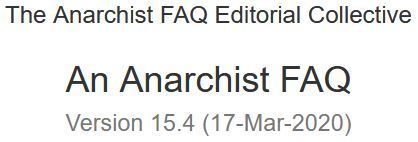
A.2.8 Is it possible to be an anarchist without opposing hierarchy?
No. We have seen that anarchists abhor authoritarianism. But if one is an anti-authoritarian, one must oppose all hierarchical institutions, since they embody the principle of authority. For, as Emma Goldman argued, “it is not only government in the sense of the state which is destructive of every individual value and quality. It is the whole complex authority and institutional domination which strangles life. It is the superstition, myth, pretence, evasions, and subservience which support authority and institutional domination.” [Red Emma Speaks, p. 435] This means that “there is and will always be a need to discover and overcome structures of hierarchy, authority and domination and constraints on freedom: slavery, wage-slavery [i.e. capitalism], racism, sexism, authoritarian schools, etc.” [Noam Chomsky, Language and Politics, p. 364]
Thus the consistent anarchist must oppose hierarchical relationships as well as the state. Whether economic, social or political, to be an anarchist means to oppose hierarchy. The argument for this (if anybody needs one) is as follows:
“All authoritarian institutions are organised as pyramids: the state, the private or public corporation, the army, the police, the church, the university, the hospital: they are all pyramidal structures with a small group of decision-makers at the top and a broad base of people whose decisions are made for them at the bottom. Anarchism does not demand the changing of labels on the layers, it doesn’t want different people on top, it wants us to clamber out from underneath.” [Colin Ward, Anarchy in Action, p. 22]
Hierarchies “share a common feature: they are organised systems of command and obedience” and so anarchists seek “to eliminate hierarchy per se, not simply replace one form of hierarchy with another.” [Bookchin, The Ecology of Freedom, p. 27] A hierarchy is a pyramidally-structured organisation composed of a series of grades, ranks, or offices of increasing power, prestige, and (usually) remuneration. Scholars who have investigated the hierarchical form have found that the two primary principles it embodies are domination and exploitation. For example, in his classic article “What Do Bosses Do?” (Review of Radical Political Economy, Vol. 6, No. 2), a study of the modern factory, Steven Marglin found that the main function of the corporate hierarchy is not greater productive efficiency (as capitalists claim), but greater control over workers, the purpose of such control being more effective exploitation.
Control in a hierarchy is maintained by coercion, that is, by the threat of negative sanctions of one kind or another: physical, economic, psychological, social, etc. Such control, including the repression of dissent and rebellion, therefore necessitates centralisation: a set of power relations in which the greatest control is exercised by the few at the top (particularly the head of the organisation), while those in the middle ranks have much less control and the many at the bottom have virtually none.
Since domination, coercion, and centralisation are essential features of authoritarianism, and as those features are embodied in hierarchies, all hierarchical institutions are authoritarian. Moreover, for anarchists, any organisation marked by hierarchy, centralism and authoritarianism is state-like, or “statist.” And as anarchists oppose both the state and authoritarian relations, anyone who does not seek to dismantle all forms of hierarchy cannot be called an anarchist. This applies to capitalist firms. As Noam Chomsky points out, the structure of the capitalist firm is extremely hierarchical, indeed fascist, in nature:
“a fascist system… [is] absolutist — power goes from top down … the ideal state is top down control with the public essentially following orders. “Let’s take a look at a corporation… [I]f you look at what they are, power goes strictly top down, from the board of directors to managers to lower managers to ultimately the people on the shop floor, typing messages, and so on. There’s no flow of power or planning from the bottom up. People can disrupt and make suggestions, but the same is true of a slave society. The structure of power is linear, from the top down.” [Keeping the Rabble in Line, p. 237]
David Deleon indicates these similarities between the company and the state well when he writes:
“Most factories are like military dictatorships. Those at the bottom are privates, the supervisors are sergeants, and on up through the hierarchy. The organisation can dictate everything from our clothing and hair style to how we spend a large portion of our lives, during work. It can compel overtime; it can require us to see a company doctor if we have a medical complaint; it can forbid us free time to engage in political activity; it can suppress freedom of speech, press and assembly — it can use ID cards and armed security police, along with closed-circuit TVs to watch us; it can punish dissenters with ‘disciplinary layoffs’ (as GM calls them), or it can fire us. We are forced, by circumstances, to accept much of this, or join the millions of unemployed… In almost every job, we have only the ‘right’ to quit. Major decisions are made at the top and we are expected to obey, whether we work in an ivory tower or a mine shaft.” [“For Democracy Where We Work: A rationale for social self-management”, Reinventing Anarchy, Again, Howard J. Ehrlich (ed.), pp. 193–4]
Thus the consistent anarchist must oppose hierarchy in all its forms, including the capitalist firm. Not to do so is to support archy — which an anarchist, by definition, cannot do. In other words, for anarchists, ”[p]romises to obey, contracts of (wage) slavery, agreements requiring the acceptance of a subordinate status, are all illegitimate because they do restrict and restrain individual autonomy.” [Robert Graham, “The Anarchist Contract, Reinventing Anarchy, Again, Howard J. Ehrlich (ed.), p. 77] Hierarchy, therefore, is against the basic principles which drive anarchism. It denies what makes us human and “divest[s] the personality of its most integral traits; it denies the very notion that the individual is competent to deal not only with the management of his or her personal life but with its most important context: the social context.” [Murray Bookchin, Op. Cit., p. 202]
Some argue that as long as an association is voluntary, whether it has a hierarchical structure is irrelevant. Anarchists disagree. This is for two reasons. Firstly, under capitalism workers are driven by economic necessity to sell their labour (and so liberty) to those who own the means of life. This process re-enforces the economic conditions workers face by creating “massive disparities in wealth … [as] workers… sell their labour to the capitalist at a price which does not reflect its real value.” Therefore:
“To portray the parties to an employment contract, for example, as free and equal to each other is to ignore the serious inequality of bargaining power which exists between the worker and the employer. To then go on to portray the relationship of subordination and exploitation which naturally results as the epitome of freedom is to make a mockery of both individual liberty and social justice.” [Robert Graham, Op. Cit., p. 70]
It is for this reason that anarchists support collective action and organisation: it increases the bargaining power of working people and allows them to assert their autonomy (see section J).
Secondly, if we take the key element as being whether an association is voluntary or not we would have to argue that the current state system must be considered as “anarchy.” In a modern democracy no one forces an individual to live in a specific state. We are free to leave and go somewhere else. By ignoring the hierarchical nature of an association, you can end up supporting organisations based upon the denial of freedom (including capitalist companies, the armed forces, states even) all because they are “voluntary.” As Bob Black argues, ”[t]o demonise state authoritarianism while ignoring identical albeit contract-consecrated subservient arrangements in the large-scale corporations which control the world economy is fetishism at its worst.” [The Libertarian as Conservative, The Abolition of Work and other essays, p. 142] Anarchy is more than being free to pick a master.
Therefore opposition to hierarchy is a key anarchist position, otherwise you just become a “voluntary archist” — which is hardly anarchistic. For more on this see section A.2.14 ( Why is voluntarism not enough?).
Anarchists argue that organisations do not need to be hierarchical, they can be based upon co-operation between equals who manage their own affairs directly. In this way we can do without hierarchical structures (i.e. the delegation of power in the hands of a few). Only when an association is self-managed by its members can it be considered truly anarchistic.
We are sorry to belabour this point, but some capitalist apologists, apparently wanting to appropriate the “anarchist” name because of its association with freedom, have recently claimed that one can be both a capitalist and an anarchist at the same time (as in so-called “anarcho” capitalism). It should now be clear that since capitalism is based on hierarchy (not to mention statism and exploitation), “anarcho”-capitalism is a contradiction in terms. (For more on this, see Section F)
#faq#anarchy faq#revolution#anarchism#daily posts#communism#anti capitalist#anti capitalism#late stage capitalism#organization#grassroots#grass roots#anarchists#libraries#leftism#social issues#economy#economics#climate change#climate crisis#climate#ecology#anarchy works#environmentalism#environment#solarpunk#anti colonialism#mutual aid#cops#police
33 notes
·
View notes
Text
Why Marxists Oppose Individual Terror (excerpt) - Trotsky 1911
Our class enemies are in the habit of complaining about our terrorism. What they mean by this is rather unclear. They would like to label all the activities of the proletariat directed against the class enemy’s interests as terrorism. The strike, in their eyes, is the principal method of terrorism. The threat of a strike, the organisation of strike pickets, an economic boycott of a slave-driving boss, a moral boycott of a traitor from our own ranks—all this and much more they call terrorism. If terrorism is understood in this way as any action inspiring fear in, or doing harm to, the enemy, then of course the entire class struggle is nothing but terrorism. And the only question remaining is whether the bourgeois politicians have the right to pour out their flood of moral indignation about proletarian terrorism when their entire state apparatus with its laws, police and army is nothing but an apparatus for capitalist terror!
However, it must be said that when they reproach us with terrorism, they are trying—although not always consciously—to give the word a narrower, less indirect meaning. The damaging of machines by workers, for example, is terrorism in this strict sense of the word. The killing of an employer, a threat to set fire to a factory or a death threat to its owner, an assassination attempt, with revolver in hand, against a government minister—all these are terrorist acts in the full and authentic sense. However, anyone who has an idea of the true nature of international Social Democracy ought to know that it has always opposed this kind of terrorism and does so in the most irreconcilable way.
Why?
‘Terrorising’ with the threat of a strike, or actually conducting a strike is something only industrial workers can do. The social significance of a strike depends directly upon first, the size of the enterprise or the branch of industry that it affects, and second, the degree to which the workers taking part in it are organised, disciplined, and ready for action. This is just as true of a political strike as it is for an economic one. It continues to be the method of struggle that flows directly from the productive role of the proletariat in modern society.
#communism#socialism#marxism#leftism#communist#leftist#marxist#socialist#anti capitalism#dismantle capitalism#luigi mangione#free luigi#terrorism#terrorist#trotsky#leon trotsky#marx#karl marx#lenin#vladimir lenin#soviet power#workers power#workers councils#all power to the soviets#leninist#leninism#bolshevik#bolshevism
9 notes
·
View notes
Text
Bangladesh's parliament has been dissolved, a day after prime minister Sheikh Hasina was forced from power.
Ms Hasina resigned and fled the country after weeks of student-led protests spiralled into deadly unrest.
The dissolution of parliament, a key demand of protesters, paves the way for establishing an interim government.
Bangladeshis are waiting to see what comes next, as the country's military chief is holding talks with political leaders and protest organisers.
According to local media, more than 100 people died in violent clashes across Bangladesh on Monday, the single deadliest day since mass demonstrations began.
Hundreds of police stations were also torched, with the Bangladesh Police Service Association (BPSA) declaring a strike "until the security of every member of the police is secure".
The group also sought to place the blame at the door of authorities, saying they were "forced to fire".
Overall, more than 400 people are believed to have died, as protests were met with harsh repression by government forces.
The protests began in early July with peaceful demands from university students to abolish quotas in civil service jobs, but snowballed into a broader anti-government movement.
Weeks of unrest culminated in the storming of the prime minister's official residence, not long after Ms Hasina had fled to neighbouring India, ending nearly 15 years of rule.
Bangladeshi leaders are under pressure to establish an interim government to avoid a power vacuum that could lead to further clashes.
Within hours of her resignation, Bangladesh's army chief Gen Waker-uz-Zaman pledged that an interim administration would be formed, adding on state television that "it is time to stop the violence".
Student leaders have been clear they will not accept a military-led government, pushing for Nobel Peace Prize winner Muhammad Yunus to become the interim government's chief adviser.
Mr Yunus, who agreed to take up the role, said: “When the students who sacrificed so much are requesting me to step in at this difficult juncture, how can I refuse?”
He is returning to Dhaka from Paris, where he is undergoing a minor medical procedure, according to his spokesperson.
Meanwhile, ex-prime minister and key opposition leader Khaleda Zia was released from years of house arrest, a presidential statement said.
She chairs the Bangladesh Nationalist Party (BNP), which boycotted elections in 2014 and again in 2024, saying free and fair elections were not possible under Ms Hasina.
The BNP wanted the polls to be held under a neutral caretaker administration. This has now become a possibility after the departure of Ms Hasina, who had always rejected this demand.
Ms Zia, 78, served as prime minister of Bangladesh from 1991 to 1996, but was imprisoned in 2018 for corruption, although she said the charges were politically motivated.
She was not the only opposition figure to be released after years of detention.
Activist Ahmad Bin Quasem was also released from detention, according to his lawyer Michael Polak.
Rights groups say Mr Quasem was taken away by security forces in 2016, just one of hundreds of forced disappearances in the country under Ms Hasina's rule.
"There were many points during his detention that he was feared dead, and the uncertainty was one of the many tools of repression utilised by the regime," Mr Polak explained, adding they hoped the decision to release political prisoners "is a positive sign of their intentions".
"Unfortunately, the good news won’t be shared by all," he told the BBC, stating that a number of political prisoners had died in custody.
At least 20 other families of political prisoners gathered outside a military intelligence force building in the capital Dhaka earlier in the day, still desperately waiting for news about their loved ones, AFP news agency reports.
"We need answers," Sanjida Islam Tulee, a co-ordinator of Mayer Daak (The Call of the Mothers) campaign group, told the news agency.
Across the border in India, Foreign Minister S Jaishankar said he was "deeply concerned till law and order is visibly restored" in Bangladesh, with which India shares a 4,096-km (2,545-mile) border and has close economic and cultural ties.
He gave the first official confirmation that Ms Hasina made a request to travel to India at "very short notice" and "arrived yesterday evening in Delhi".
India also deployed additional troops along its border with Bangladesh.
"Our border guarding forces have also been instructed to be exceptionally alert in view of this complex situation," Mr Jaishankar said.
14 notes
·
View notes
Text
Human rights in Russia have “severely deteriorated” since the full-scale invasion of Ukraine, culminating in a “systematic crackdown” on civil society, a UN report has found.
The investigation details police brutality, widespread repression of independent media and persistent attempts to silence Kremlin critics using punitive new laws.
Mariana Katzarova, the UN’s special rapporteur on human rights in Russia, was denied entry into the country and compiled the report by speaking to political groups, activists and lawyers.
She found “credible reports” of torture and allegations of sexual violence, rape and threats of sexual abuse by police.
The Kremlin has not commented publicly since its release.
Human rights abuses in Russia have been well documented during the Vladimir Putin era, but the latest UN report pays particular attention to how the February 2022 invasion of Ukraine has accelerated what it says was previously a “steady decline”.
It details how laws passed in recent years targeting the spread of so-called fake news, and individuals or organisations deemed to have received foreign support, have sought to “muzzle” any opposition, both physically and online.
The new laws have led to “mass arbitrary arrests” and long prison sentences, it adds.
Among the cases the report highlights is that of Artyom Kamardin, who was jailed for seven years for reading an anti-war poem in public - an act authorities deemed to be “inciting hatred”.
Ms Katzarova told the BBC: “Russians are getting shockingly long prison sentences.
"It’s seven years for reading an anti war-poem, or saying a prayer by a priest which was against the war, or producing a play perceived to be anti-war. Two women are still in prison for that in Russia.”
She praised those who continue to organise despite threats and said she believes opposition to the war is quietly widespread.
“As in any totalitarian, authoritarian state, people don't want to get in trouble - it doesn't mean that they are supportive of some madness, an aggressive war against their neighbour,” she added.
The report accuses the government of seeking to propagate its views on the Ukraine conflict among children via the introduction of mandatory school lessons, officially labelled as “important conversations”.
“Children refusing to attend such classes and their parents are subject to pressure and harassment,” it adds. The report highlights the case of a fifth-grader from Moscow who was interrogated by police after skipping the class, before their mother was charged with “failing to fulfil parental duties”.
It found that many men sent to Ukraine “have been mobilised by deception, the use of force, or by taking advantage of their vulnerability”, while those who have refused to fight have been held in detention centres in occupied areas and “threatened with execution, violence or a prison sentence if they did not return to the front lines”.
Men from indigenous communities make up a disproportionate number of those drafted into the army, it found, and there is evidence “authorities have imposed travel restrictions, blocking exit routes from towns and villages during mobilisation sweeps”.
Ms Katzarova said: “Indigenous people… are really facing extinction if this continues.
"I think, partly my guess and the trends that indigenous leaders are painting, is that this is part of the Russian authorities really wanting to send to the front line ‘disposable people’, not the Slavs from St Petersburg or Moscow.”
Elsewhere in the report:
It accuses judges of acting as a “mouthpiece” for the government because of the depth of political interference
It describes Russia as an “increasingly homophobic society”, pointing to recent laws curtailing the freedoms of LGBT+ people
It says female anti-war activists have been disproportionately affected by the crackdown on dissent and are “even more vulnerable in custody”
It describes a “climate of fear and repression” amid widespread police brutality in Chechnya, adding that the southern republic should serve as a “warning” for what could happen elsewhere in Russia
The report deals with human rights in Russia’s internationally recognised borders, so does not comment on reported abuses in Russian-occupied territories in Ukraine, Georgia and Moldova.
9 notes
·
View notes
Text
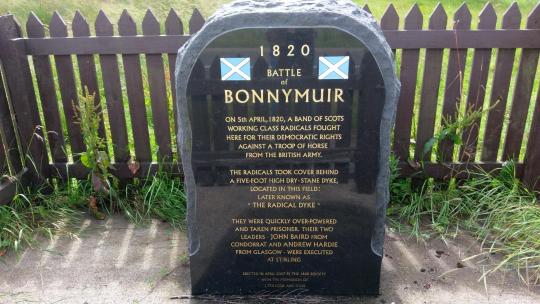
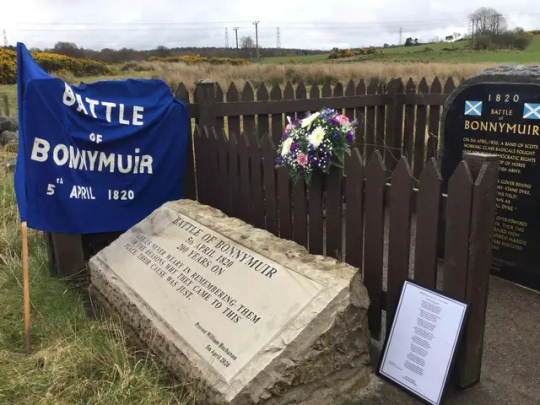
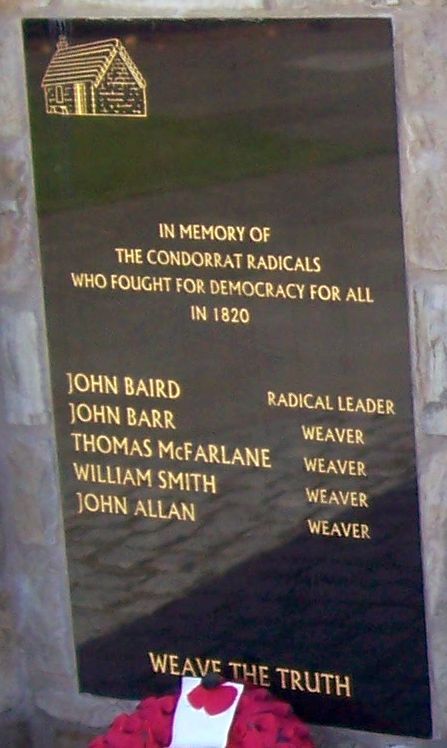
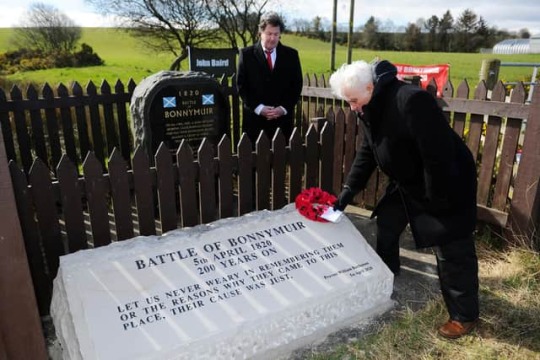
On 5th April 1820 government forces defeated Radical weavers at what became known as the Battle of Bonnymuir.
The ‘Radical Rising’ or ‘Radical War’ of 1820, also known as the Scottish Insurrection of 1820, was a week of strikes and unrest in Scotland that culminated in the trial of a number of ‘radicals’ for the crime of treason. It was the last armed uprising on Scottish soil, with the intent of establishing a radical republic.
Based in Central Scotland, artisan workers (such as weavers, shoemakers, blacksmiths), initiated a series of strikes and social unrest during the first week of April 1820. This pushed for government reform, in response to the economic depression. The Rising was quickly, and violently, quashed, and the subsequent trials took place in Scotland from July to August 1820.
The events of the Rising followed years of economic recession after the end of the Napoleonic Wars and considerable revolutionary instability on the European continent. As the economic situation worsened for many workers, societies sprung up across the country which espoused radical ideas for fundamental change.
In the early nineteenth century, Scottish politics offered power to very few people. Councillors on the Royal Burghs at this time were not elected to their position, rich landowners controlled county government and there were fewer than 3,000 parliamentary voters in the whole of Scotland, hardly a democracy.
It was recognised that the key to change was electoral reform, and the events of the American Revolution of 1776 and French Revolution of 1789 helped to promote these ideas. Radical reformers began to seek the universal franchise (for men), annual parliaments, and the repeal of the Act of Union of 1707.
Between 1st and 8th April 1820, across central Scotland, some works stopped, particularly in weaving communities, and radicals attempted to fulfil a call to rise. Several disturbances occurred across the country, perhaps the worst of which were the events at Bonnymuir, Stirlingshire, where a group of about 50 radicals clashed with a patrol of around 30 soldiers, while Bonnymuir is the most famous, or should I say infamous of the events during this period, it was by no means the only “uprising”
On Monday April 3rd a strike took force across a wide area of Scotland including Stirlingshire, Dunbartonshire, Renfrewshire, Lanarkshire and Ayrshire, with an estimated total of around 60,000 stopping work.
Reports were made of men carrying out military drill in Glasgow while foundries and forges had been raided, and iron files and dyer's poles taken to make pikes. In Kilbarchan soldiers found men making pikes, in Stewarton around 60 strikers was dispersed, in Balfron around 200 men had assembled for some sort of action. Pikes, gunpowder and weapons called "wasps" (a sort of javelin) and "clegs" (a barbed shuttlecock to throw at horses) were offered for sale.
In Glasgow John Craig led around 30 men to make for the Carron Company ironworks in Falkirk, telling them that weapons would be there for the taking, but the group were scattered when intercepted by a police patrol. Craig was caught, brought before a magistrate and fined, but the magistrate paid his fine for him.
Rumours spread that England was in arms for the cause of reform and that an army was mustering at Campsie commanded by Marshal MacDonald, a Marshal of France and son of a Jacobite refugee family, to join forces with 50,000 French soldiers at Cathkin Braes under Kinloch, the fugitive "Radical laird" from Dundee.
Government troops were ready in Glasgow, including the Rifle Brigade, the 83rd Regiment of Foot, the 7th and 10th Hussars and Samuel Hunter's Glasgow Sharpshooters. In the evening 300 radicals briefly skirmished with a party "of cavalry", but no one came to harm.
The next day, Tuesday April 4th, Duncan Turner assembled around 60 men to march to Carron, while he carried out organising work elsewhere. Half the group dropped out, however the remaining twenty five, persuaded that they would pick up support along the way, set out under the leadership of Andrew Hardie. They arrived in Condorrat, which was on the way to Carron, at 5am on April 5th. Waiting for them was John Baird who had expected a small army, not this bedraggled and soaking wet group. He was persuaded to continue the March to Carron by John King, who would himself go ahead and gather supporters. King would go to find supporters at Camelon while Baird and Hardie were to leave the road and wait at Bonnymuir.
What the leaders didn’t know is that the Government had placed spies and agitators among the crowds and they were lured to the confrontation with well-armed, trained soldiers on Bonnymuir,
The authorities at Kilsyth and Stirling Castle had however been alerted and Sixteen Hussars and sixteen Yeomanry troopers had been ordered on 4 April to leave Perth and go to protect Carron. They left the road at Bonnybridge early on April 5th and made straight for the slopes of Bonnymuir. As the newspapers subsequently reported:
"On observing this force the radicals cheered and advanced to a wall over which they commenced firing at the military. Some shots were then fired by the soldiers in return, and after some time the cavalry got through an opening in the wall and attacked the party who resisted till overpowered by the troops who succeeded in taking nineteen of them prisoners, who are lodged in Stirling Castle. Four of the radicals were wounded".
The Glasgow Herald mocked the small number of radicals encountered, but worried that "the conspiracy appears to be more extensive than almost anyone imagined... radical principles are too widely spread and too deeply rooted to vanish without some explosion and the sooner it takes place the better."
The end of the Rising
On the afternoon of April 5th, before news of the Bonnymuir fighting got out, Lees sent a message asking the radicals of Strathaven to meet up with the "Radical laird" Kinloch's large force at Cathkin. The next morning a small force of 25 men followed the instructions and left at 7 a.m. to march there. Among them was the experienced elderly Radical James Wilson who is claimed to have had a banner reading "Scotland Free or a Desart"
At East Kilbride they were warned of an army ambush, and Wilson, suspecting treachery, returned to Strathaven. The others bypassed the ambush and reached Cathkin, but as there was no sign of the promised army they dispersed. Ten of them were identified and caught, and by nightfall on April 7th; they were jailed at Hamilton.
I’ll leave things there for the moment, the aftermath will be told in further posts, one in a few days, and more as the ringleaders were made examples of as they were tried for their parts in the events.
The large memorial stone to mark the 200th anniversary of the Battle of Bonnymuir was unveiled in April 2021.
20 notes
·
View notes
Text
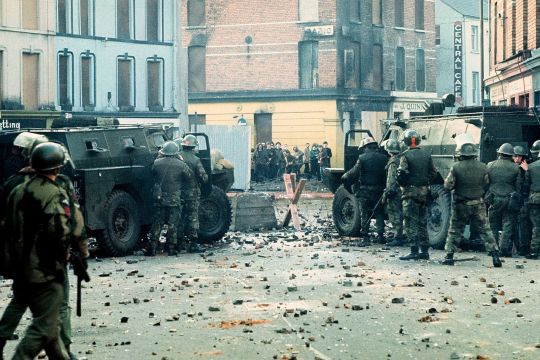
30 January 1972: Bogside Massacre, or the Bloody Sunday
Bogside Massacre, or the Bloody Sunday, was a massacre on 30 January 1972 in the Bogside area of Derry, Northern Ireland, when British soldiers shot 26 civilians during a protest march against internment without trial. Fourteen people died: 13 were killed outright, while the death of another man four months later was attributed to his injuries. Many of the victims were shot while fleeing from the soldiers, and some were shot while trying to help the wounded. Other protesters were injured by shrapnel, rubber bullets, or batons, and two were run down by army vehicles. All of those shot were Catholics. The march had been organised by the Northern Ireland Civil Rights Association (NICRA). The soldiers were from the 1st Battalion, Parachute Regiment (“1 Para”), the same regiment implicated in the Ballymurphy massacre several months prior.
Two investigations were held by the British government. The Widgery Tribunal, held in the immediate aftermath, largely cleared the soldiers and British authorities of blame. It described the soldiers’ shooting as “bordering on the reckless”, but accepted their claims that they shot at gunmen and bomb-throwers. The report was widely criticised as a “whitewash”. The Saville Inquiry, chaired by Lord Saville of Newdigate, was established in 1998 to reinvestigate the incident. Following a 12-year investigation, Saville’s report was made public in 2010 and concluded that the killings were both “unjustified” and “unjustifiable”. It found that all of those shot were unarmed, that none were posing a serious threat, that no bombs were thrown and that soldiers “knowingly put forward false accounts” to justify their firing. The soldiers denied shooting the named victims but also denied shooting anyone by mistake. On publication of the report, the British prime minister David Cameron made a formal apology on behalf of the United Kingdom. Following this, police began a murder investigation into the killings.
Bloody Sunday came to be regarded as one of the most significant events of the Troubles, because many civilians were killed by forces of the state, in full view of the public and the press. It was the highest number of people killed in a single shooting incident during the conflict and is considered the worst mass shooting in Northern Irish history. Bloody Sunday fuelled Catholic and Irish nationalist hostility towards the British Army and worsened the conflict. Support for the Provisional Irish Republican Army (IRA) rose, and there was a surge of recruitment into the organisation, especially locally.
In all, 26 people were shot by the paratroopers; 13 died on the day and another died of his injuries four months later. The dead were killed in four main areas: the rubble barricade across Rossville Street, the courtyard car park of Rossville Flats (on the north side of the flats), the courtyard car park of Glenfada Park, and the forecourt of Rossville Flats (on the south side of the flats).
All of the soldiers responsible insisted that they had shot at, and hit, gunmen or bomb-throwers. No soldier said he missed his target and hit someone else by mistake. The Saville Report concluded that all of those shot were unarmed and that none were posing a serious threat. It also concluded that none of the soldiers fired in response to attacks, or threatened attacks, by gunmen or bomb-throwers. No warnings were given before soldiers opened fire.
The casualties are listed in the order in which they were killed.
John ‘Jackie’ Duddy, age 17. Shot as he ran away from soldiers in the car park of Rossville Flats. The bullet struck him in the shoulder and entered his chest. Three witnesses said they saw a soldier take deliberate aim at the youth as he ran. He was the first fatality on Bloody Sunday. Both Saville and Widgery concluded that Duddy was unarmed.
Michael Kelly, age 17. Shot in the stomach while standing at the rubble barricade on Rossville Street. Both Saville and Widgery concluded that Kelly was unarmed. The Saville Inquiry concluded that 'Soldier F’ shot Kelly.
Hugh Gilmour, age 17. Shot as he ran away from soldiers near the rubble barricade. The bullet went through his left elbow and entered his chest. Widgery acknowledged that a photograph taken seconds after Gilmour was hit corroborated witness reports that he was unarmed. The Saville Inquiry concluded that 'Private U’ shot Gilmour.
William Nash, age 19. Shot in the chest at the rubble barricade. Three people were shot while apparently going to his aid, including his father Alexander Nash.
John Young, age 17. Shot in the face at the rubble barricade, apparently while crouching and going to the aid of William Nash.
Michael McDaid, age 20. Shot in the face at the rubble barricade, apparently while crouching and going to the aid of William Nash.
Kevin McElhinney, age 17. Shot from behind, near the rubble barricade, while attempting to crawl to safety.
James 'Jim’ Wray, age 22. Shot in the back while running away from soldiers in Glenfada Park courtyard. He was then shot again in the back as he lay mortally wounded on the ground. Witnesses, who were not called to the Widgery Tribunal, stated that Wray was calling out that he could not move his legs before he was shot the second time. 'Soldier F’ faces charges for his murder.
William McKinney, age 26. Shot in the back as he attempted to flee through Glenfada Park courtyard. 'Soldier F’ faces charges for his murder.
Gerard 'Gerry’ McKinney, age 35. Shot in the chest at Abbey Park. A soldier, identified as 'Private G’, ran through an alleyway from Glenfada Park and shot him from a few yards away. Witnesses said that when he saw the soldier, McKinney stopped and held up his arms, shouting “Don’t shoot! Don’t shoot!”, before being shot. The bullet apparently went through his body and struck Gerard Donaghy behind him.
Gerard 'Gerry’ Donaghy, age 17. Shot in the stomach at Abbey Park while standing behind Gerard McKinney. Both were apparently struck by the same bullet. Bystanders brought Donaghy to a nearby house. A doctor examined him, and his pockets were searched for identification. Two bystanders then attempted to drive Donaghy to hospital, but the car was stopped at an Army checkpoint. They were ordered to leave the car and a soldier drove the vehicle to a Regimental Aid Post, where an Army medical officer pronounced Donaghy dead. Shortly after, soldiers found four nail bombs in his pockets. The civilians who searched him, the soldier who drove him to the Army post, and the Army medical officer, all said that they did not see any bombs. This led to claims that soldiers planted the bombs on Donaghy to justify the killings.
Patrick Doherty, age 31. Shot from behind while attempting to crawl to safety in the forecourt of Rossville Flats. The Saville Inquiry concluded that he was shot by 'Soldier F’, who came out of Glenfada Park. Doherty was photographed, moments before and after he died, by French journalist Gilles Peress. Despite testimony from 'Soldier F’ that he had shot a man holding a pistol, Widgery acknowledged that the photographs show Doherty was unarmed, and that forensic tests on his hands for gunshot residue proved negative.
Bernard 'Barney’ McGuigan, age 41. Shot in the back of the head when he walked out from cover to help Patrick Doherty. He had been waving a white handkerchief to indicate his peaceful intentions. The Saville Inquiry concluded that he was shot by 'Soldier F’.
John Johnston, age 59. Shot in the leg and left shoulder on William Street 15 minutes before the rest of the shooting started. Johnston was not on the march, but on his way to visit a friend in Glenfada Park. He died on 16 June 1972; his death has been attributed to the injuries he received on the day. He was the only fatality not to die immediately or soon after being shot.
Paul McCartney (who is of Irish descent) recorded the first song in response only two days after the incident. The single, entitled “Give Ireland Back to the Irish”, expressed his views on the matter. This song was one of few McCartney released with Wings to be banned by the BBC.
The 1972 John Lennon album Some Time in New York City features a song entitled “Sunday Bloody Sunday”, inspired by the incident, as well as the song “The Luck of the Irish”, which dealt more with the Irish conflict in general. Lennon, who was of Irish descent, also spoke at a protest in New York in support of the victims and families of Bloody Sunday.
Irish poet Thomas Kinsella’s 1972 poem Butcher’s Dozen is a satirical and angry response to the Widgery Tribunal and the events of Bloody Sunday.
Black Sabbath’s Geezer Butler (also of Irish descent) wrote the lyrics to the Black Sabbath song “Sabbath Bloody Sabbath” on the album of the same name in 1973. Butler stated, “…the Sunday Bloody Sunday thing had just happened in Ireland, when the British troops opened fire on the Irish demonstrators… So I came up with the title 'Sabbath Bloody Sabbath’, and sort of put it in how the band was feeling at the time, getting away from management, mixed with the state Ireland was in.”
The Roy Harper song “All Ireland” from the album Lifemask, written in the days following the incident, is critical of the military but takes a long-term view with regard to a solution. In Harper’s book (The Passions of Great Fortune), his comment on the song ends “…there must always be some hope that the children of 'Bloody Sunday’, on both sides, can grow into some wisdom”.
Brian Friel’s 1973 play The Freedom of the City deals with the incident from the viewpoint of three civilians.
Irish poet Seamus Heaney’s Casualty (published in Field Work, 1981) criticizes Britain for the death of his friend.
The Irish rock band U2 commemorated the incident in their 1983 protest song “Sunday Bloody Sunday”.
Christy Moore’s song “Minds Locked Shut” on the album Graffiti Tongue is all about the events of the day, and names the dead civilians.
The events of the day have been dramatised in two 2002 television films, Bloody Sunday (starring James Nesbitt) and Sunday by Jimmy McGovern.
The Celtic metal band Cruachan addressed the incident in a song “Bloody Sunday” from their 2004 album Folk-Lore.
Willie Doherty, a Derry-born artist, has amassed a large body of work which addresses the troubles in Northern Ireland. “30 January 1972” deals specifically with the events of Bloody Sunday.
In mid-2005, the play Bloody Sunday: Scenes from the Saville Inquiry, a dramatisation based on the Saville Inquiry, opened in London, and subsequently travelled to Derry and Dublin. The writer, journalist Richard Norton-Taylor, distilled four years of evidence into two hours of stage performance at the Tricycle Theatre. The play received glowing reviews in all the British broadsheets, including The Times: “The Tricycle’s latest recreation of a major inquiry is its most devastating”; The Daily Telegraph: “I can’t praise this enthralling production too highly… exceptionally gripping courtroom drama”; and The Independent: “A necessary triumph”.
In October 2010, T with the Maggies released the song “Domhnach na Fola” (Irish for “Bloody Sunday”), written by Mairéad Ní Mhaonaigh and Tríona Ní Dhomhnaill on their debut album.
Read more about the Bogside Massacre
Daily inspiration. Discover more photos at Just for Books…?
28 notes
·
View notes